Control Household Insect Pests
Contents
Managing Household Insect Pests
Buying and Using Insecticides Inside the Home
Ants (small, home-invading species)
House Flies and Other Large Flies
Fruit Flies, Drain Flies, and Other Small Flies
For information on other household insect pests:
Publication 3346 Control Cockroaches in and around Your Home
Publication 2597 Control Fleas on Your Pet, in Your House, and in Your Yard
Publication 2546 Bed Bugs and What to Do about Them
Publication 3690 Prevention and Treatment of Nuisance Bees around Your Home
Publication 2429 Control Fire Ants in Your Yard
Publication 2154 Spiders: Brown Recluse and Black Widow
Insects and spiders are abundant in Mississippi; we have thousands of species. Most are harmless, and many are beneficial, providing valuable services such as pollination, serving as predators or parasites to help keep pest populations in check, or providing food for birds and other animals. Some are considered pests because they feed on animals or crops we grow for food, fiber, or timber, or because they damage ornamental plants.
Many species invade our homes and apartments. Some, such as Asian lady beetles and other occasional invaders, are just nuisances, but they can be quite bothersome when they occur in high numbers. Pests such as cockroaches and houseflies simply want to live with us and feed on our leftovers. Others, like sawtoothed grain beetles and other stored product pests, eat our food before we can. Termites and other structural pests eat our homes, and still others, such as fleas and bed bugs, eat us!
This publication provides basic information on the identification, biology, and habits of common household insects and spiders. It also provides information on how to keep these pests from getting into your home in the first place and how to control them when they do get inside.
Managing Household Insect Pests
Before reading about a specific insect pest, consider some of the general principles of managing household insects and spiders: exclusion, sanitation, proper identification, and understanding pest biology and habits. Don't underestimate the value of these basic principles.
Exclusion
Exclusion is the most important part of household insect control. Don't let pests get into your home in the first place, and you won't have a pest problem. Sure, insects are small and can crawl through tiny cracks, but hardware and home-improvement stores sell a variety of screens, weather stripping, caulking, sealants, and other supplies you can use to seal even the smallest cracks. Time spent making sure your home is as “bug tight” as possible reduces the number of insects that get inside and saves money by conserving energy. Just don't be overzealous. Be sure to maintain adequate ventilation for health and safety.
You can also use exclusion on a smaller scale. Keep food products like cereals, flour, and grains in insect-proof containers and you are much less likely to have problems with stored-product pests. Store your wool suits and sweaters properly and they are less likely to be infested with clothes moths or carpet beetles.
Another, often overlooked, aspect of exclusion is being careful about what items you bring into your home. German cockroaches like to hide in radios, TVs, and other electrical appliances—like that computer monitor your cousin has offered to give you. Used mattresses and box springs can harbor bed bugs. Those boxes of old books from Aunt Emma's estate may contain silverfish or brown recluse spiders. You don't need to be paranoid about bringing second-hand items into your home, but you do need to be informed and act wisely.
Sanitation
Sanitation is another cornerstone of household pest management. Deprive pests of a food source and they won't become established in your home. Good sanitation is especially important in controlling pests such as cockroaches. Regular cleaning and vacuuming, combined with other good sanitation practices, are more useful than insecticide sprays when it comes to discouraging roaches. Decluttering is another powerful pest-management tool that goes hand in hand with sanitation. Cluttered, crowded storage areas provide shelter for spiders and insect pests and interfere with other treatment efforts.
Identify the Pest
Know your enemy! Sometimes it's not enough to know whether it is a cockroach or an ant. You need to know which cockroach or which species of ant. Management and treatment strategies can vary greatly depending on species. If you aren't sure, collect some specimens, place them in a small, leak-proof bottle of alcohol, and take them to your county Extension office. Extension personnel can send the specimens to a specialist for identification.
Understand Pest Biology
Once you've identified the pest you are trying to control, it's important to learn about its biology and habits. Where does this pest spend most of its time? Where do the immature stages feed, and what do they look like? What does it eat? Knowing the answers to these and other questions can help you plan an effective control strategy.
Buying and Using Insecticides Inside the Home
Insecticides can be useful tools for controlling indoor insect pests, but they are not substitutes for exclusion and sanitation. If you rely solely on insecticides to manage your indoor insect problems, you are going to use a lot of insecticide, and you still may not succeed. Still, sometimes you may need to use an insecticide.
Choosing and Purchasing Insecticides
The number of different insecticide products labeled and sold for indoor pest control is huge, and it is easy to become confused or overwhelmed when shopping for the right product for a particular pest problem. Just because a product has a picture of an ant or roach on the label or is called “ant and roach spray” does not necessarily mean it is the best solution for your particular ant or roach problem.
The first step in choosing a pesticide is to decide what type of formulation you want. Do you want a ready-to-use spray? Do you want an insecticide concentrate to mix and apply using your hand pump sprayer? Or do you need a bait?
Once you have decided on a formulation, you need to think about the active ingredient. The brand names of household insecticides are sometimes long and confusing and often don't provide a lot of useful information about what the product is really good for. Learn to choose insecticides based on their active ingredients. The names of insecticide active ingredients do sound somewhat technical (such as cyfluthrin, fipronil, and hydramethylnon), but they aren't nearly as long and confusing as most of the brand names.
The most important step in purchasing a household insecticide is to read the label carefully—before you buy it! Take your glasses, take your time, and read it right there in the store. Be sure it contains the active ingredient you want and is the formulation you need. Be sure it is labeled to control the pest(s) you need to control, and read how to use and apply the product. Be sure it is labeled for indoor use in the site you plan to treat. If you need to use it in your kitchen cabinets, be sure it is labeled for use in kitchen cabinets, and read how to apply the product safely. Read the label again once you get home—just before you treat.
Using Insecticides Safely and Effectively
Insecticides are like fire or automobiles. When used properly, they are safe, useful tools, but they can be dangerous if misused. The most important step in safe insecticide use is to read the label and do what it says. Be sure you know what you are using and how to use it safely.
Use common sense when applying insecticides. You want to put them where they will contact the pests, and you want to avoid putting them where they will contact you, family members, or pets. Be especially careful when treating in kitchens and dining areas. Remove or cover all food items before spraying, and don't let spray drops or mist contaminate cooking utensils or food preparation surfaces. If you are using a liquid spray, avoid spraying electrical outlets and other electrical sources.
The keys to effective insecticide use are to prepare the area properly before you start treating, target your treatment to the areas where the pest lives, and be thorough. Note that being thorough does not mean applying large amounts of insecticide; it means being sure to identify and treat all the places the pest occurs.
Start by cleaning and removing clutter if necessary. You will often need to empty storage cabinets or closets to be able to treat thoroughly. You may even have to drill small access holes to allow treatment of voids where pests may be hiding, like the space beneath most floor-level cabinets, which is a good hiding place for roaches.
Think about where the pest hides, and place your treatment in those areas. Try to find and treat all the areas that might harbor pests. Remember, insecticides aren't magic potions that cause pests to disappear just because you apply a little spray or dust. If the pest doesn't contact the insecticide, it won't be controlled.
Insecticide Formulations
Ready-to-use sprays: Many indoor insecticides are sold as prediluted, ready-to-use sprays. Often, they are sold in small, trigger-pump spray bottles, but some are sold in gallon containers that have hand-pressurized, or even battery-powered, pumps. Most of the insecticides sold in this way give broad-spectrum control, and they are convenient to keep on hand for occasional pest problems.
Aerosol sprays: Aerosol sprays are ready-to-use insecticide sprays sold in pressurized cans. They are quick and convenient for small jobs, but they are costly. Some come with a small “straw” or extension tube that lets you inject spray into cracks, crevices, and wall voids. Be especially sure to read the label when purchasing aerosol sprays. Some contain active ingredients, like pyrethrins, that provide quick kill but give no residual control; others contain active ingredients that provide quick kill and long-term residual control. Some are labeled for use as space sprays to control flying insect pests; others are not.
Insecticide concentrates: Insecticide concentrates have to be diluted in water before you can apply them. Liquid concentrates are the most common form, but some insecticides are sold as wettable powders or wettable granules, and some are even sold in premeasured, water-soluble packets. Read the label to find out how much product to mix, and don't be tempted to use more than the label indicates. If the label says to dilute 1 teaspoon in a gallon of water, just use 1 teaspoon. Increasing the rate of an insecticide spray above the labeled rate won't improve control. Increasing the care and thoroughness with which you apply that spray will.
Total-release aerosol foggers: These are simply aerosol sprays that release all of their contents at once. The spray button locks into place when you push it down, and the contents of the can empty into the room. These are most often sold for flea or roach control. While they can be useful when dealing with especially heavy infestations, they are usually not the best formulation for flea or roach control. This is because most of the insecticide ends up on surfaces that don't really need to be treated, and the spray does not penetrate well into the cracks and crevices where many pests hide.
Baits: Baits usually contain a small amount of insecticide diluted in a product that the target pests readily eat. They are most often used to control ants or cockroaches, and baits are very effective tools for controlling these pests. Baits are especially useful against German cockroaches. The active ingredients used in baits are usually slow-acting insecticides or insect growth regulators. Baits are formulated as pastes or gels that come in small, syringe-like tubes, as liquids, or granules. Most of the baits sold for home use come in small bait stations that allow the target pests to access the bait but prevent access by children or pets.
Dusts: A few household insecticides are formulated as dusts. These are best applied using a handheld bulb duster to puff the dust into cracks, crevices, and voids that harbor pests. The main advantage of dusts is they usually provide long-lasting control in the areas where they are applied. Do not apply dusts to exposed areas. Dusts belong in out-of-the-way places where family members or pets can't come in contact with them.
Ants (small, home-invading species)
About 180 species of ants live in Mississippi, and some occasionally invade homes. Table 1 lists the six species that invade homes most often. Four of these, Argentine ants, Linepithema humile; odorous house ants, Tapinoma sessile; little black ants, Monomorium minimum; and dark rover ants, Brachymyrmex patagonicus, are relatively small ants the average homeowner rarely notices as long as the ants stay outdoors. It is when they invade the home and begin foraging in the kitchen or in other areas of the home that these ants become pests.
This section focuses on these four species, but the information on controlling these species can also be applied to other types of small, home-invading ants, such as Pharoah ants or acrobat ants. Imported fire ants and carpenter ants are addressed in separate sections.
Table 1. Pest ants most commonly encountered in Mississippi homes.
|
Common Name |
Size |
Color |
Comment |
|
Argentine ant |
1/10 inch, workers uniform in size |
light to medium brown |
No sting. Fast moving ant. Commonly forages indoors. Crushed or disturbed ants smell musty. |
|
odorous house ant |
1/10 inch, workers uniform in size |
light to dark brown |
No sting. Fast moving ant. Commonly forages indoors. Crushed or disturbed ants smell like rotten coconut. |
|
little black ant |
1/12 inch, workers uniform in size |
shiny black |
Have a weak sting. Slower moving than Argentine or odorous house ants. |
|
dark rover ant |
1/12 inch, workers uniform in size |
dark brown |
No sting. Move in a jerky, stutter-step manner. Have many small, isolated nest sites. |
|
imported fire ant |
1/12 to 3/16 inch, workers vary in size |
light to dark brown |
Sting aggressively. Stings cause long-lasting wheals. Some people are highly sensitive to stings. |
|
black carpenter ant |
1/4 to 1/2 inch, workers vary in size |
black |
No sting but can bite and spray formic acid. Large black ants cause structural damage by tunneling in wood. Prefer moist wood. |
Argentine Ants
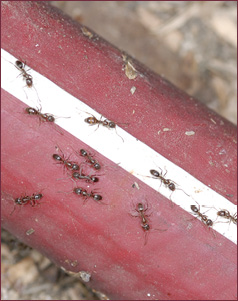
Argentine ants, Linepithema humile, are light to medium brown. The workers are uniform in size and are about 1/12 inch long. These ants have a distinctive musty odor you can detect when you crush individual ants or disturb a nest. The foraging workers move quickly and form narrow trails up trees, along the sides of buildings, and inside homes. As with most ants, the trails usually follow some type of structural edge, such as the edge of a wall or walkway.
Argentine ants are a nonnative species that has spread over much of the state. Ecologically, they are very aggressive ants that displace other species, including fire ants. Their nests are inconspicuous, located under fallen leaves, organic mulch, tree bark, and in other protected sites, including indoor locations. Unlike fire ants, which form one large nest, a colony of Argentine ants usually has dozens of smaller, interconnected nests. Infested landscapes, especially those with large numbers of trees and shrubs, may support huge numbers of Argentine ants, which can be seen trailing up trees and over the sides of buildings and other structures.
Argentine ants can be challenging to control, especially in landscapes with many trees and shrubs that result in accumulations of leaf litter and/or organic mulch immediately adjacent to the home. Treatment should focus on nonchemical tactics that exclude ants from the home, limit access to food items, and make the area immediately around the home less favorable for foraging and nesting. Exterior perimeter insecticide treatments can play an important role in controlling Argentine ants. These ants are difficult to control with baits, but liquid sweet baits or gel baits can be useful to control isolated indoor nests.
Odorous House Ants
Like Argentine ants, the workers of odorous house ants, Tapinoma sessile, are relatively uniform in size, but they are slightly larger, approximately 1/10 inch. These ants have a distinctive odor when individual ants are crushed or nests are disturbed that is often compared to rotten coconuts.
Odorous house ants are a native species that has many habits in common with Argentine ants. Argentine ants are more ecologically aggressive and have displaced odorous house ants in many areas. Like Argentine ants, odorous house ants form relatively small, inconspicuous nests under leaf litter, mulch, tree bark, and other protected sites, and a single colony usually has many interconnected nest sites, some of which may be located indoors. They tend to move nest sites frequently, especially if disturbed.
Control of odorous house ants is similar to that for Argentine ants. This ant is readily attracted to liquid sweet baits, and baits can be useful in controlling indoor infestations.
Little Black Ants
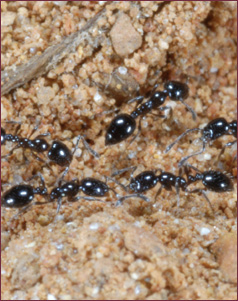
As their name implies, little black ants, Monomorium minimum, are small, about 1/12 inch, and shiny black. Unlike Argentine ants and odorous house ants, little black ants can sting, but compared to fire ants, the sting is relatively minor.
This is a common outdoor species that nests in sites similar to those of Argentine ants and odorous house ants. They are especially fond of nesting in or under rotting wood. Colonies are generally much smaller than the other two species, and fewer workers are usually present on foraging trails. Also, foraging workers move slower than the other two species. Liquid sweet baits are useful to control indoor infestations. Exterior perimeter treatments can help prevent reinfestation.
Dark Rover Ants
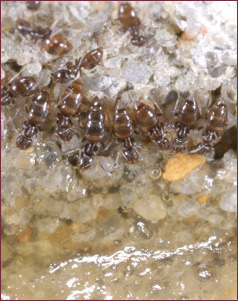
The dark rover ant, Brachymyrmex patagonicus, is an invasive ant species that continues to spread through the state. It is becoming more of a problem in homes as well as commercial buildings. These tiny ants are similar to little black ants in size and are often mistaken for little black ants. Close examination will reveal that they are dark brown, rather than black, and are not shiny like little black ants. They also move along their trails in a jerky, or stutter-step, manner.
Dark rover ants live in small, isolated colonies outdoors (under rocks, in soil, in leaf litter and plant mulch, and in similar locations) as well as indoors (under siding and shingles, in wall voids, in foam insulation, under flooring, and in similar locations). These ants can be annoyingly difficult to control because they may produce large numbers of small, isolated colonies inside buildings. This makes it difficult to eliminate all colonies in an area. Ants from one nest site may respond to your bait station and be eliminated, while foragers from another nest do not. Baits are useful treatments, but thoroughness and persistence are key to controlling rover ants.
Control of Small, Home-Infesting Ants
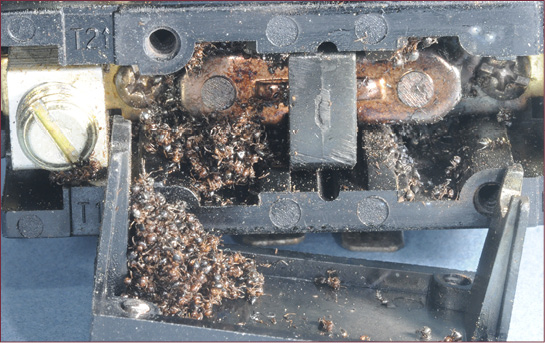
Because control tactics may vary greatly, depending on which species of ant is present, proper identification is the first step in controlling home-invading ants. Even when controls are relatively similar, as for Argentine ants and odorous house ants, it can be helpful to know exactly which species you are trying to control. Because most species of ants are small, it may be necessary to collect samples and send them to an entomologist who has a microscope and good identification keys.
Short-term control of home-invading ants can be as simple as locating their trail, wiping it away with a damp, soapy cloth, and removing the food source that was attracting the ants or storing it in an ant-proof container. Without their scent trail, the ants lose their way to the food source and are forced either to reestablish the trail or forage elsewhere. If you can follow the trail to where the ants are entering the house, apply an appropriately labeled insecticide there to discourage the ants from reestablishing the trail. This is most effective when an outdoor colony has only recently established a single foraging trail into the home. But if heavy populations are in or around the home, they likely will return eventually, especially if they have nests already established in the home or have readily available routes into the home.
Long-term control of home-invading ants can be quite challenging, requiring a combination of methods and much persistence and patience. Some of the practices that are most useful in controlling home-invading ants are discussed below.
Table 2. Ready-to-use insecticides to control home-invading ants.
|
Active Ingredient |
Brand Name (Examples) |
|
bifenthrin (0.05%) + zeta-cypermethrin (0.0125%) |
Ortho Home Defense Insect Killer |
|
cyfluthrin (0.05%) |
BioAdvanced Complete Insect Killer |
|
deltamethrin (0.02%) |
Bonide Household Insect Control |
|
gamma-cyhalothrin (0.025%) |
Spectracide Bug Stop Home Barrier |
|
permethrin (0.25%) |
Viper RTU |
Locate and Treat Nest Sites
Look for foraging trails, and try to follow them back to their source. It is especially important to find and treat any nest sites inside the home. Although it is usually impossible to locate all nest sites, especially all outdoor sites, this is an important first step. When you find a nest site, treat it with an appropriately labeled bait or residual insecticide. If you think the ants are nesting indoors but can't find or access the nest, use baits as described in a following section.
When choosing an insecticide, read the label carefully before you purchase the product, and be sure it is labeled for the use you have in mind. If you need to treat inside the home, be sure the insecticide is specifically labeled for indoor use. Note that two products having the same active ingredient may have very different labels; one may be formulated specifically for indoor use, while another may be restricted to outdoor use.
- Examples of insecticides you can use to treat indoor infestations of ants include aerosol sprays containing active ingredients such as prallethrin + tralomethrin, prallethrin + esfenvalerate, or pyrethrins + PBO + permethrin, or ready-to-use trigger pump sprays containing active ingredients such as bifenthrin, cyfluthrin, permethrin, deltamethrin, or tralomethrin. You can treat nest sites inside walls or other voids with an insecticide dust containing the active ingredient deltamethrin or with dusts containing silica or diatomaceous earth. Use a commercially available bulb duster that lets you inject dusts through cracks or small holes drilled into the target void. If you can't find dust applicators locally, you can order them online.
- Some of the more useful active ingredients to look for in insecticides to be used to treat outdoor ant colonies include bifenthrin, cyfluthrin, deltamethrin, lambda-cyhalothrin, or permethrin.
Eliminate Attractive Food Sources
Do this through sanitation and by storing food products in ant-proof containers. If pet food bowls are the cause of the problem, this can be as simple as limiting the amount of time you let pets eat before removing the food, rather than giving the pet, and consequently the ants, free access to the food. But you may also have to search the home thoroughly to identify and remove food sources or store them in ant-proof containers. Storing foods in ant-proof containers or in the refrigerator or freezer is a key ant-management tool, especially in homes that suffer chronic infestations. This also helps prevent infestations of other stored food pests.
Seal Entry Points
Although it is usually impossible to locate and seal all potential entry points, sealing points where you have observed trails entering the house can help divert foragers to other, outside food sources. When sealing cracks and entryways for ant control, keep in mind that it is important to keep adequate ventilation of the home for health and safety reasons.
Prune Trees and Shrubs
Limbs of trees or shrubs that touch the exterior of the house provide convenient travel routes for foraging ants to enter. Keeping limbs and branches pruned away from the house can aid greatly in ant control. Also, remove any ivy or other vines growing on the house, since vines can provide nesting sites and travel routes.
Control Honeydew-Producing Insects on Landscape Plants
Because these ants thrive on honeydew produced by pests such as aphids, scales, and whiteflies, controlling these pests on landscape plants aids in ant control. See Extension Publication 2369 Insect Pests of Ornamental Plants in the Home Landscape for information on how to control honeydew-producing insects.
Avoid Excessive Mulch and Leaf Litter, Especially Immediately Adjacent to the House
Because these ants readily nest in the moist, protected environment provided by organic mulch or leaf litter, keeping mulch and leaves away from the foundation wall of the house and avoiding the use of too much mulch aids in control. Where feasible, use rock, pea gravel, or some other nonorganic mulch in the area next to the foundation. Maintaining a 3- to 4-foot-wide mulch- and leaf-free band around the immediate perimeter of the house can aid greatly in ant control. This also helps prevent termites.
Use Appropriate Baits Properly
Baits are the best treatments for eliminating indoor nest sites that you cannot find and treat directly, but be sure to use the right kind of bait. Baits designed to control fire ants usually are not very effective against these small, home-invading ants, and these ants are not as easy to control with baits as are fire ants. Also, most fire ant baits are not labeled for indoor use.
Examples of baits that can be useful against home-invading ants include liquid sweet baits, gel baits, and bait stations. These contain active ingredients such as orthoboric acid, disodium octaborate tetrahydrate, fipronil, abamectin, or dinotefuran. Finely ground granular baits, containing ingredients such as orthoboric acid or abamectin, may also be useful in some situations. When using baits, it is important to supply bait to all locations where ants are foraging. If you are finding ants in the kitchen, den, and bathroom, bait all three locations. Appropriate baits may also be placed outside where foraging trails are observed, but outdoor infestations are often difficult to control with baits simply because of the large numbers of ants involved. This is especially true with Argentine ants.
Place bait along foraging trails where the ants will find it readily, and keep replenishing bait as long as the ants continue to forage on it. Keep in mind that baits are intended to work slowly, so that they will be carried back to the nest site and spread throughout the nest, to both adult and immature ants, eventually eliminating the entire nest. Don't spray insecticides in areas where you are using baits because this may repel ants and prevent them from taking the bait. Likewise, don't disturb the foraging trails to the bait in any other way; just keep checking and replenishing the bait as needed. If you really want to eliminate the nest, you will just have to tolerate the trailing ants for a few days.
Table 3. Baits to control home-invading ants.
|
Active Ingredient |
Brand Name (Examples) |
|
thiamethoxam 0.003% |
Raid Ant Gel |
|
imidacloprid 0.03% |
Maxforce Quantum Ant Bait |
|
sodium tetraborate 5.4% |
Terro Liquid Ant Baits |
|
boron sodium oxide 6% |
Gourmet Ant Bait Gel |
|
indoxacarb 0.05% |
HotShot MaxAttrax Ant Bait Station |
|
indoxacarb 0.05% |
Advion Ant Gel |
|
abamectin 0.01% |
Raid Ant Baits III |
|
abamectin 0.011% |
Enforcer Ant Max Bait Stations |
|
dinotefuran 0.05% |
Hot Shot Ultra Liquid Ant Bait |
|
fipronil 0.01% |
MaxForce FC Ant Bait Stations |
|
fipronil 0.001% |
MaxForce FC Ant Killer Bait Gel |
Apply Perimeter Insecticide Treatments
When outdoor populations are heavy, resulting in continuous reinvasion of the home, as is often the case with Argentine ants, it can be helpful to apply a residual insecticide to a 3- to 10-foot-wide band around the perimeter of the house. The objective of these perimeter treatments is to control any nests in the area and control or discourage foraging workers from nests farther away from the home.
Examples of active ingredients used in insecticides labeled for such perimeter treatments include bifenthrin, carbaryl, cyfluthrin, deltamethrin, lambda-cyhalothrin, and permethrin. Some of these products are sold in ready-to-use hose-end applicators, which is a convenient, effective way to apply such treatments. Read and follow label directions carefully. Some labels allow treatment of a portion of the outer wall of the home and around doorways and windows, while others do not, and the width of the treated band varies depending on which product is used. Don't expect these treatments to penetrate heavy accumulations of mulch or leaf litter and control nests underneath. If you have this situation, rake the mulch or leaf litter back before treating to improve control.
Hire a Professional Pest Control Company
Professional technicians have access to useful treatments that are not readily available to do-it-yourselfers and are better equipped to drill and treat wall voids if such treatments are necessary. Most companies have experienced technicians who know and understand how to deal with ant problems. But don't expect an overnight solution. The technician still has to use the methods discussed above, and it can take time and several repeat visits to get results. Once you have control, continued service is usually required to keep the ants from returning.
Table 4. Outdoor perimeter insecticide treatments to control home-invading ants.
|
Active Ingredient |
Brand Name (Example) |
|
bifenthrin (0.3%) |
Ortho Home Defense Ready-to-Spray |
|
bifenthrin (0.3%) + zeta-cypermethrin (0.075%) |
Ortho BugClear Ready-to-Spray |
|
bifenthrin (2.4%) |
Hi-Yield Bug Blaster Ready-to-Spray |
|
beta-cyfluthrin (0.36%) + imidacloprid (0.72%) |
Bioadvanced Complete Insect Killer |
|
zeta-cypermethrin (0.35%) |
GardenTech Sevin Insect Killer Concentrate |
|
gamma-cyhalothrin (0.08%) |
Spectracide Triazicide Insect Killer Concentrate |
|
permethrin (10%) |
Hi-Yield Garden, Pet, & Livestock Insect Control |
|
permethrin (38%) |
Hi-Yield 38 Plus, Turf, Termite, & Ornamental |
Imported Fire Ants
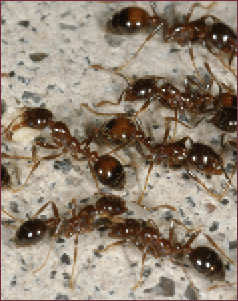
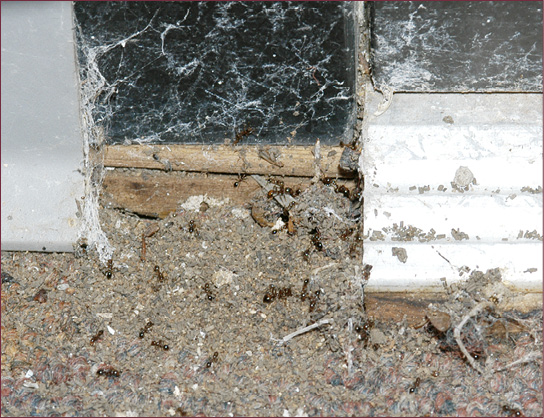
Imported fire ants, Solenopsis spp., are nonnative ants that invaded the state in the early part of the 20th century. They now occur throughout the state and are one of the most economically important insect pests in the South. They are primarily outdoor pests, where they cause problems because of their aggressive stinging and the severe reactions many people have to being stung. Their large mounds are unsightly and can damage equipment, and fire ants also cause direct agricultural and ecological damage. Extension Publication 2429 Control Fire Ants in Your Yard provides more detailed information on fire ants and recommendations for controlling these pests outdoors.
Indoor invasions of imported fire ants are relatively uncommon, especially considering how abundant these ants are, but they do occur. Because of their aggressive stinging nature, indoor invasions of fire ants must be dealt with promptly. Indoor fire ant invasions happen for two different reasons.
The first, and most common, situation occurs when workers find their way into the home and begin foraging on food items such as pet food or spilled food or crumbs. In this case, usually a single trail of workers comes into the house and carries food back out of the house to a nearby mound. The second situation occurs when a colony of fire ants located near the foundation of the home is disturbed, either by physical activities such as digging, landscaping, or improper insecticide applications or by environmental conditions such as flooding or drought, and attempts to move the entire colony indoors. In this case, you usually see large numbers of workers carrying their white brood into the house. The ants may also bring particles of soil into the house. These displaced colonies are usually very agitated and will sting aggressively and in large numbers.
Controlling Indoor Fire Ant Invasions
Control of home-invading fire ants must be quick and complete. In cases where a single trail of foraging workers is entering the house, the first step is to follow the trail of ants to where they enter the house and then try to follow them outside of the house to their nest site (do not treat the nest site at this time). After you locate the nest site, go back inside, and spray the trailing ants with an insecticide labeled for indoor use, being especially sure to treat where the ants are entering the home.
Aerosol sprays containing active ingredients such as prallethrin + tralomethrin, prallethrin + esfenvalerate, or pyrethrins + PBO + permethrin, or ready-to-use trigger pump sprays containing active ingredients such as bifenthrin, cyfluthrin, permethrin, deltamethrin, or tralomethrin kill fire ants quickly. In an emergency, you can use dishwashing liquid diluted in water (about 1 fl. oz./gal.). Spray the ants with this solution and they will die within minutes, but it won't provide any residual control.
The next step is to clean up the food on which the ants were foraging, and, if necessary, store it in ant-proof containers. If the ants were foraging on pet food, a common cause of indoor fire ant invasions, it may be necessary to limit the amount of time you leave out the pet food.
The final step is to treat the mound or nest site where the ants originated. Do not physically disturb the colony or agitate it by spraying it with the spray you used to control the ants indoors, because this could cause the colony to move, and they could move indoors. The goal is to eliminate the entire colony quickly and completely. This is best done using a liquid drench treatment.
To apply a liquid drench properly to an outdoor mound, choose an appropriately labeled product containing an active ingredient such as bifenthrin, cyfluthrin, or permethrin, and mix the right amount of insecticide (this will be clearly specified on the label) with 1 to 2 gallons of water in a watering can, bucket, or other suitable container. Pour about a fourth of this drench in a 10- to 12-inch band around the mound, and then slowly pour the rest of the drench directly over the mound. The key to quick, successful control is to use enough drench to thoroughly soak the mound; large mounds require higher volumes of drench than small mounds. It is especially important to achieve quick, complete control when treating mounds near the foundation, because colonies not completely controlled will relocate, possibly moving into the home.
When a colony of fire ants has already invaded the home, treatment is similar, though the number of ants involved may be much larger. Use contact insecticides such as those mentioned above to control ants that have moved inside. Allow time for the ants to die and for the spray to dry, then use a broom and dustpan or a vacuum to clean up the ants. If part of the colony is still located outside the building, control it using drench treatments as described above.
Preventing Indoor Fire Ant Invasions
Indoor invasions of fire ants almost always originate from a mound near the foundation of the building. The most effective way to prevent indoor fire ant invasions is to proactively control fire ants around the immediate outside of the building. This is most easily and cost-effectively done by using specially formulated fire ant baits or by applying broadcast residual insecticide treatments containing active ingredients such as bifenthrin. See Extension Publication 2429 for a list of recommended products.
Apply baits by broadcasting them in a band approximately 25 feet wide around the perimeter of the house. Many homeowners choose to treat the entire lawn. In landscapes where fire ants are abundant, apply bait treatments two to three times per year, in spring, midsummer, and fall, for maximum control. The key to success with baits is to apply them broadcast, rather than attempting to treat individual mounds, and to be proactive. Don't wait until large mounds appear.
If you use residual insecticide treatments, such as bifenthrin, broadcast in a band around the perimeter of the house according to label directions. Unlike bait treatments, which ants collect and carry to the mound, residual insecticide treatments work by contact activity. They kill foraging ants as they move through or over treated soil.
Regardless of whether you use baits or residual insecticide treatments, the objective is to keep the area immediately around the outside of the building free of fire ant mounds. Check this area regularly, and treat any active mounds with liquid drench treatments.
See Extension Publication 2429 Control Fire Ants in Your Yard for more detailed information on outdoor fire ant control.
Carpenter Ants
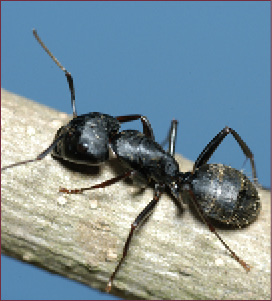
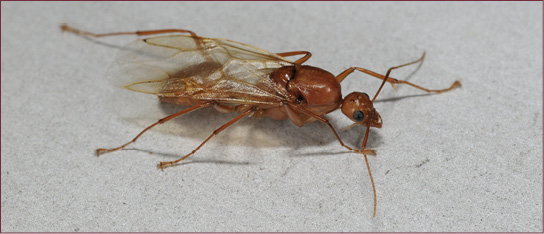
Several species of carpenter ants occur in the state, but the black carpenter ant, Campanotus pensylvanicus, is the most common pest species. You can easily identify black carpenter ants by their large size (workers vary from ¼ to ½ inch long) and dull black color. Although these ants do not sting, they can bite and spray formic acid from their abdomens.
Carpenter ants are common in wooded areas and in landscapes where trees are present. In nature, these ants nest by tunneling in dead wood. They are especially fond of large hollow trees or standing dead trees. Although they tunnel in wood, carpenter ants do not actually eat wood. Instead, they feed on live and dead insects as well as honeydew that aphids and other insects produce. They also feed on fruits and plant exudates. In homes, they forage on sweet items such as jellies, syrups, and pastries, as well as meats and other foods.
Carpenter ants become pests when they enter homes either to forage or to establish nests. Although having foraging carpenter ants inside often indicates the ants are nesting indoors, ants sometimes enter homes from trees or other types of wood located just outside the building. Nests in buildings are usually located in moist or decaying wood, though they occasionally tunnel and nest in sound, dry wood. Nests in homes may be in roofs, underneath shingles, in fascia board or soffit voids, in floor or wall voids, and in similar locations. These are large ants, and sometimes you can hear them as they move about or chew on wood in walls or ceilings. Despite their ability to cause structural damage, it is their trailing and foraging habits that usually cause the greatest concern to homeowners.
Carpenter Ant Control
Indoor infestations of carpenter ants often mean some type of moisture problem resulting from structural or plumbing leaks. One of the first concerns is to determine where the ants are nesting and, if the nest is indoors, find out if such leaks exist and need to be repaired. Carpenter ants forage most actively at night, so using a flashlight to follow foraging trails back to their source is one of the best ways to locate nest sites.
If you can find the nest sites, treat them directly with insecticides labeled for this type of indoor use. Premixed, ready-to-use insecticides containing active ingredients such as cyfluthrin, deltamethrin, lambda-cyhalothrin, or permethrin provide both contact and residual control. Use insecticide dusts containing active ingredients such as deltamethrin to treat nests in inaccessible cracks or voids. Apply dust treatments using a special bulb duster to inject dust through small holes drilled into the void.
Baits are one of the easiest and most effective ways to control carpenter ants. Carpenter ants do not readily accept baits formulated for fire ants or other indoor pest ants, but they readily take specially formulated carpenter ant baits. Unfortunately, these baits are difficult to find locally. Usually, you have to order them from mail or Internet suppliers, but they usually work well enough that they are worth the extra effort and expense.
One granular bait, Advance Granular Carpenter Ant Bait, contains the active ingredient abamectin. You can apply this bait outdoors to eliminate colonies nesting in trees, as well as in basements, attics, crawl spaces, garages, and such. You can also use it to treat cracks, crevices, or voids where carpenter ants are nesting. Another bait, Maxforce Carpenter Ant Bait Gel, contains fipronil and is primarily for indoor use, though it is also labeled for use in certain outdoor situations. The best way to use baits is to place them along foraging trails and near nest sites. Keep providing bait as long as the ants are taking it. Do not apply insecticide sprays near baiting locations, because these will repel ants from the bait site. Be sure to read and carefully follow label directions.
Carpenter Bees
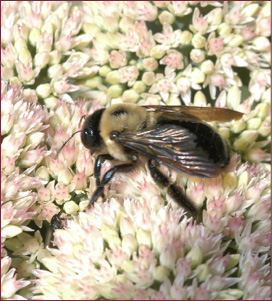
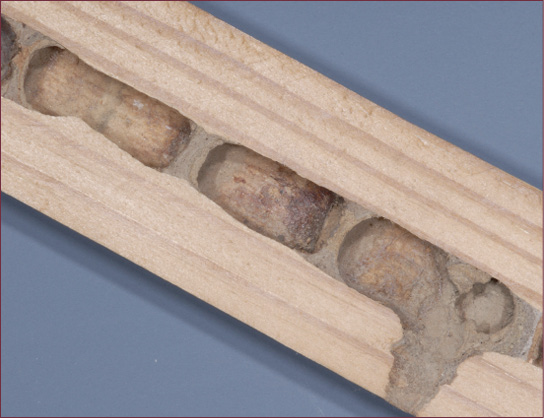
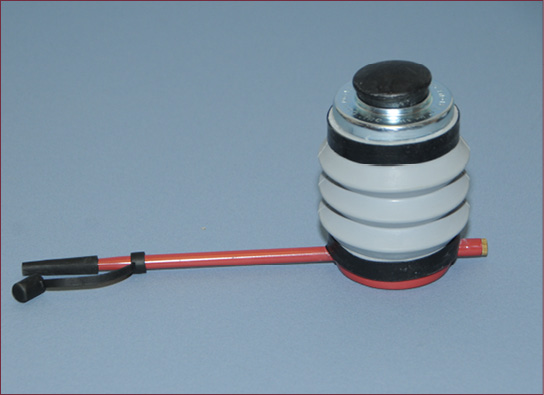
Eastern carpenter bees, Xylocopa virginica, are often mistaken for bumble bees. Although they look a lot like bumble bees, there is a big difference in their biology and behavior. Carpenter bees are solitary bees that bore holes into wooden structures for their nests. Bumble bees are social bees that nest in the ground. One of the most easily observed physical differences is that the top of the abdomen of carpenter bees is slick and shiny, while bumble bees are covered with black, white, or yellow hairs.
There are several species of carpenter bees, but the eastern carpenter bee is by far the most common. The “white-faced” males are hard to miss because of their habit of buzzing about, hovering in mid-air and occasionally in people's faces. Some people feel threatened by this behavior, but the males are harmless because they do not sting. Many people can remember playing with “white-faced bumble bees” as children.
Female carpenter bees can sting, but they are not aggressive and do not sting unless forced to do so. It is very uncommon for someone to get stung by a carpenter bee. Females are easily distinguished from males because their faces are solid black, while the males have the distinct white spot in the middle of the face. Females also behave differently than males. They don't have time for the idle buzzing and aerial acrobatics of the males. They spend their time boring nesting galleries, collecting pollen and nectar to provision the gallery, and laying eggs. Galleries, which are about ½ inch in diameter and may be up to 2 feet long, are most commonly made in unpainted softwood lumber. They especially prefer pine, cypress, and cedar but will occasionally bore into other types of lumber. Carpenter bees do not eat wood; they just use it for their nest galleries.
Carpenter bees tend to congregate around favorable nesting locations, and females will reuse and enlarge old galleries from year to year. Although carpenter bee damage is usually relatively minor, multiple galleries can weaken timbers. Galleries can also allow moisture to enter the wood and hasten decay. There are two generations per year, one in spring and one in fall, and carpenter bees overwinter as immatures inside these galleries.
Carpenter Bee Prevention and Control
Painted or sealed wood is seldom attacked by carpenter bees, so this is the best long-term method of prevention. When using paint to prevent carpenter bee attack, it is important for the paint or sealant coat to be thick enough to totally cover the wood grain. The bees will readily bore through paint as long as they can still “feel” the wood grain. Adding exterior vinyl or aluminum covering is another effective alternative to painting.
The most effective way to control carpenter bees with insecticides is to apply small amounts of insecticide dust directly into the galleries. This literally “gets 'em coming and going.” Female bees are killed when they return to the gallery, and newly hatched bees are killed when they emerge. Dusts work better and last longer than liquid or aerosol treatments because they remain in the gallery, where they will contact the bees, rather than soaking into the wood. Don't try to seal up the holes too soon after treating; wait until you are sure you have gotten control, then seal the holes and paint over the area (if the surface was painted to begin with).
There are situations where the rustic look of unpainted wood is preferred or where it may not be practical to paint the exposed beams and rafters in barns, storage sheds, and others. Because carpenter bees often reuse old galleries, just dusting the galleries and leaving them unsealed is the best way to deal with carpenter bees in unpainted wood (barns, sheds, cedar siding, and others). Treating all open galleries that you can reach a couple of times a year will allow you to reduce the carpenter bee population greatly, but you will never get 100 percent control.
Two of the most commonly available dust products are Terro Ant Dust and Hi-Yield Multi-Use Dust, which contain deltamethrin and are labeled for control of bees and wasps. There are other brands of deltamethrin dust (DeltaDust is the brand used by professional pest-control companies) and dusts containing other active ingredients (available through local distributors), but read the label carefully to verify that the product is approved for the intended use. Drione dust, which contains pyrethrins + piperonyl butoxide + silica gel, is another effective dust option. Dust can be applied quickly and easily into galleries with a bulb duster. However, bulb dusters may be difficult to find locally and may have to be specially ordered (there are several online suppliers—just search for “bulb duster”).
Be careful if you must use a ladder to treat for carpenter bees. Watch for electric lines, and don't fall!
Fabric Pests
Clothes moths and carpet beetles are pests of fabrics or other items produced from the hair, feathers, or hide of animals. Wool, mohair, or silk clothing; wool carpets or tapestries; furs; taxidermy specimens; felt hats or other felt products; and leather items are examples of items clothes moths or carpet beetles can infest. Although most people think of clothes moths when they find holes in favorite sweaters or coats, carpet beetles may also be the cause. And damage to wool carpets can be from either carpet beetles or clothes moths. Fortunately, many of the practices that prevent or control one of these pests work against the other, too.
Caution: Do not automatically assume that moths you see flying in or around closets or other areas where clothing is stored are clothes moths. They could be stored product moths, such as Indian meal moths or Angoumois grain moths. Infestations of stored food moths often occur in closets—in forgotten food items left in pockets of coats or other clothing, or in food products stored in the closet. These moths are stronger fliers than clothes moths and may fly anywhere in the house, even several rooms away from where the infested food product is. Find out which kind of pest you have by finding the infested items. If you find infested food items, see the section on stored food pests in this publication..
Clothes Moths
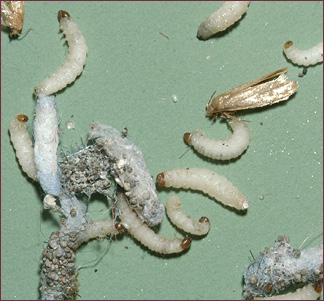

The most commonly encountered species of clothes moths are the webbing clothes moth, Tineola bisselliella, and the casemaking clothes moth, Tinea pellionella. Both are small, light-colored moths, approximately 1/4 inch long. They are weak fliers and are usually only seen near the articles they are infesting. The moths do not eat clothes; it is the small caterpillars that chew holes in the fabric. Damage is often concentrated along seams or where the clothing was folded, and soiled clothing is more susceptible to damage.
Clothes moth caterpillars grow to about 1/2 inch long. The larvae of casemaking clothes moths form a cocoon-like case, which they carry with them. Although webbing clothes moths do not produce such a case, they do produce tunnels of silk webbing. Once they mature, the caterpillars use some of the fibers from the fabric, combined with silk they produce themselves, to form a cocoon. Larvae often wander away from the infested article before pupating.
Carpet Beetles
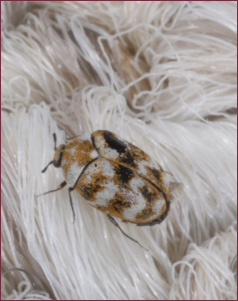
Carpet beetles belong to a group of beetles known as dermestids, which specialize in feeding on fur, feathers, hide, or other dried animal-based products. The two species most common in homes are the varied carpet beetle, Anthrenus verbasci, and the black carpet beetle, Attagenus unicolor, but there are several other species. Carpet beetles are so named because they were common pests back in the days when most carpets were made of wool, hair, or other animal-based products. They are still important pests of Oriental rugs and other types of wool carpets and tapestries. They do not feed on the synthetic carpets so common today, but they will attack blends of wool and synthetics. Carpet beetles also attack other types of stored woolen or animal-based products. They also feed on accumulations of dead insects, in abandoned nests of bees or wasps, or on dried animal carcasses—such as a dead rat or squirrel in a wall void. Carpet beetles may also feed on dried plant products such as seeds or grain.
Adult carpet beetles also feed on pollen and are often brought into the house on freshly cut flowers. Most of the damage to fabrics is caused by the larvae, which are covered with stiff, bristly hairs. Mature larvae often wander away from the site of infestation before pupating; finding wandering carpet beetle larvae indicates there is an infestation somewhere in the house. Large accumulations of shed larval skins may be in or near the site of the infestation. Remove these with a vacuum or other suitable method. Because the hairs on these shed skins can cause respiratory problems, be sure to wear an appropriate respirator when cleaning up infestations of carpet beetles, and use a vacuum equipped with a HEPA filter. Skin contact with carpet beetle larvae or shed skins or hairs from these larvae can also result in severe skin irritation or dermatitis.
Controlling Fabric Pests
The methods used to treat or prevent clothes moths or carpet beetles vary, depending on the situation. Following are some of the key steps in protecting clothing and other items.
The first step in dealing with a heavy infestation of clothes moths or carpet beetles is to methodically remove all items from the infested storage area and check them for infestation and fabric content. Assume that all woolen, silk, or other susceptible items stored in the area are infested. If clothes moths have infested that cashmere sweater on the upper shelf, they probably have infested the wool suit hanging on the other side of the closet, as well. After removing all clothing and other items from the closet or storage chest, thoroughly clean and vacuum the area. Treat or protect all susceptible items as described on the next pages before returning them to storage.
Dry cleaning is an effective means of controlling insects in an infested article of clothing. It also helps prevent infestations. Have clothing cleaned before storing for prolonged periods of time. Clothing soiled by sweat, oil, and flakes of skin is much more attractive, and much more nutritious, to clothes-damaging pests. Valuable furs and other items should be professionally cleaned and stored in cold storage. Thorough ironing will also control pests, as will machine washing of items that are safe to wash.
When cleaning is not possible, hang clothing items in a bright, sunny location, brush them thoroughly (inside and out), and leave them there for a few days. Brushing dislodges many eggs and larvae, and these insects are repelled by sunlight and attempt to flee from it.
Freezing is an effective method of controlling infestations of carpet beetles and clothes moths. Place items inside a plastic bag, force out as much air as possible (to minimize condensation), and place in the freezer for 4 to 7 days. When articles are removed from the freezer, leave them in the plastic bag until they reach room temperature, but then promptly remove them and check to be sure they are dry before returning to storage. Although this will control insects, it obviously does not clean the clothing, and soiled clothing is more likely to be reinfested. Still, freezing can be a useful, cost-effective way to ensure that sweaters or other items are bug-free before you put them back into storage.
Store clothing in “bug-tight” containers. Moths and adult carpet beetles can't lay eggs in clothing they can't reach. Sweaters and other susceptible items can be stored in plastic boxes with tight-fitting lids. Suits, skirts, and coats can be stored on hangers in specially designed storage bags or even modified garbage bags. Many dry cleaners offer to wrap clothing in moth-proof storage bags. To get the maximum protection for long-term storage, be sure bags are sealed at both ends. But don't make the mistake of assuming that clothing is immune from problems just because you store it in this way. If clothes moths or carpet beetles do get into storage boxes or bags, they thrive.
Check stored items periodically to be sure they are not infested, and promptly deal with infestations you find. In addition to checking for holes in clothing, be alert for small, light-colored moths; small, oval-shaped beetles; small, hairy larvae; or shed larval skins in the bottom of the container. Items stored in one place, without being used for long periods of time, are prime candidates for damage.
Cedar storage chests: While cedar certainly smells good, its insect-deterring properties are often overrated. Studies show it does not really repel adult clothes moths, but high concentrations of cedar oils can kill small caterpillars. Cedar can help protect clothes, but only when it is very fresh or when it has been rejuvenated with cedar oil. The storage chest must seal tightly so the cedar volatiles can build to a toxic level. Cedar-lined closets do not usually provide a tight enough seal. Many dry cleaners offer to place cleaned clothing in moth-proof bags, which are usually impregnated with cedar oil.
Moth balls or moth crystals: Neither napthalene nor paradichlorobenzene (PDB) repels adult clothes moths or carpet beetles, but, like cedar volatiles, these products kill young larvae when concentrations are high enough. Storing clothing in airtight containers with mothballs or moth crystals can prevent/control fabric pests. Because these chemicals can react with plastic items, it is important to keep them from directly contacting the items being stored or the container. Of course, both of these products smell bad, and you have to air out items before use. Be sure to carefully read and follow all label directions before using products containing naphthalene or paradichlorobenzene. These products are fumigants, meaning they volatilize and move through the air.
Pest strips: Because of limitations on where they can be used, pest strips containing dichlorvos (also known as DDVP or Vapona) are of little use for controlling clothes moths and carpet beetles. These strips may not be used in homes or other areas occupied by humans more than 4 hours per day. Their use is limited to sites such as attics, storage sheds, and crawl spaces, as well as dwellings such as vacation homes or mobile homes that will not be occupied for more than 4 months immediately following placement of the strips. Be sure to read and fully understand labels before using these products. Hot Shot No-Pest Strips and Prozap Insect Guard strips are two examples.
Insecticides: Except for infested carpets and wall tapestries, insecticides do not play a very important role in controlling fabric pests. Never spray insecticides directly on clothing. You can use properly labeled insecticides and/or insect growth regulators to treat the insides of closets, chests, or other areas where heavy infestations have occurred. Apply the insecticide after you have emptied and cleaned the closet or storage area, and let the spray dry before replacing articles. The main reason for these treatments is to control any larvae that wandered away from the infested item before pupating and escaped the cleanup effort. Be sure to treat corners, cracks, and crevices where wandering larvae may seek refuge to pupate. Several products that are labeled for this use are available to homeowners. Most contain active ingredients such as cyfluthrin, permethrin, deltamethrin, cypermethrin, or the insect growth regulator methoprene. Be sure to carefully read and follow label directions.
Insect Control in Carpets and Rugs
Carpets, rugs, and tapestries made of wool or other animal-based products are especially susceptible to infestation by carpet beetles or clothes moths. These are often antique or high-value items that require special protection. Check such items frequently for signs of infestation. Be sure to move furniture and other items resting on the carpet and check the underside. Because the larvae of these insects avoid light and prefer to feed in protected areas, they often concentrate and cause greatest damage where furniture or some other item is resting. Regular vacuuming and cleaning help prevent carpets from becoming heavily infested. Here again, it is especially important to move any items that are resting on the carpet so you can roll back the carpet and vacuum the underside as well as the top. High-value or antique rugs and tapestries should be cleaned by professionals who specialize in these items.
Insecticides and/or insect growth regulators can play an important role in protecting carpets and tapestries from infestation or controlling active infestations. Pyrethroid insecticides such as cyfluthrin or deltamethrin provide quick kill and long-term residual control of both adults and immatures. Tank-mixing a growth regulator, methoprene, or pyriproxyfen with a pyrethroid insecticide will improve long-term control. These products interfere with the development of larvae and keep adult insects from producing viable eggs. When treating infested rugs, move any furniture resting on the rug, roll back the rug, and treat the underside. Homeowners may prefer to have a professional pest-control company make these treatments.
Taxidermy Specimens
Most insect attacks on taxidermy specimens involve carpet beetles, but infestations of clothes moths occasionally occur. Infestations of specimens of small game and deer mounted by professional taxidermists are relatively uncommon. This is because boric acid is used in the mounting process, and boric acid is an effective insecticide that provides long-term residual control. But large game, such as bears and exotic game, is often mounted using a different process that provides relatively less protection from insect infestations. Regardless of the type of mounts you have, it is a good idea to check them regularly for signs of insect infestation.
If you find an infestation, contact a taxidermist or professional pest-control company to determine the best method of control. Fumigation is one option, but this must be performed by specially trained and licensed technicians who have access to special pesticides and equipment, and it is often difficult to find a company set up to perform fumigations. Freezing is another option, one that many museums use. Most fabric pests are killed by exposure to subfreezing temperatures, but it may take up to 3 weeks in the freezer to achieve control in large specimens. If specimens are frozen, be sure to protect against condensation (wrap in an air-tight plastic bag, and force out as much air as possible), and handle specimens carefully to avoid breaking fragile body parts, such as ears.
Stored Food Pests
Because of refrigeration and advances in food packaging, stored food pests are much less of a problem today than they were in the past, but they are still quite common, and most homeowners eventually have problems with bugs in the cereal, beetles in the red pepper, small moths flying about the house, or some other type of stored food pest. Infestations most commonly originate in dry food products that have been opened and then forgotten or left in storage for a long time.
Stored food pests are often referred to as “pantry pests” because infestations most often occur in the kitchen, but infestations can occur in other areas of the house, as well. Depending on the species of pest involved, infestations are not always restricted to food items; they can occur in tobacco products, dried plants, birdseed, pet food, and other types of dried plant or animal-based products. There are many species of stored food insects, but most are either beetles or moths. Some of the most commonly encountered species are briefly discussed in the following sections.
Indian Meal Moth
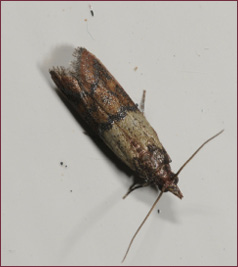
Indian meal moth, Plodia interpunctella, is one of the most common stored food pests. Infestations are most often found in stored grain products such as corn, wheat, or birdseed, or in nuts or dried fruit.
The moths are about 1/3 inch and have a distinctive two-toned appearance—cream on the front half and copper on the back half—and are easy to identify when you can observe them at rest. Moths are often seen flying about the house, but because they are strong fliers, the source of the infestation may not necessarily be in the room where you first see the moths.
The caterpillars are white with a medium-brown head and are about 1/2 inch long when fully mature. They produce large amounts of dust-covered silk webbing. When they are ready to pupate, the caterpillars often chew their way out of the food packaging and wander some distance away, often crawling up walls. Pupae are often found at the juncture of the wall and ceiling or along the undersides of shelves where they meet the wall. Don't forget to check these areas when cleaning up infestations.
Angoumois Grain Moth
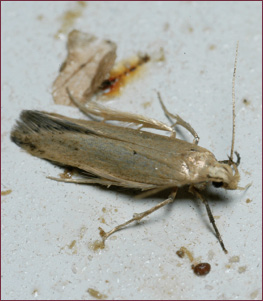
The caterpillars of the Angoumois grain moth, Sitotroga cerealella, bore into whole-grain kernels and eat the grain from the inside out. They are one of our most damaging stored grain pests, especially in commercial grain production. They attack stored whole grains such as corn, barley, rice, or other whole seeds. Decorative ears of Indian corn are one of the most common sources of infestations in homes.
The moths are about 1/3 inch and dirty white. Because they have fringed hind wings, they are sometimes mistaken for clothes moths. The larvae pupate inside the infested grain after cutting a small hole through which to exit once they become moths.
Confused Flour Beetle
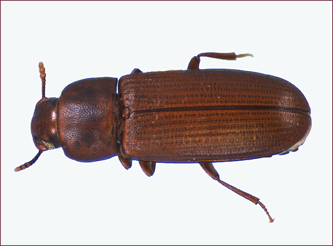
The confused flour beetle, Tribolium confusum, and its near relative the red flour beetle commonly infest processed grain products such as flour, oatmeal, and cereals. Adults are about 1/8 inch, reddish-brown, elongate beetles. The long, slender larvae are dirty white. Although these insects can't bore into whole grains, they are often found in whole grain infested with other insect pests that can bore into grain. The flour beetles feed on the flour other pests produce.
Sawtoothed Grain Beetle
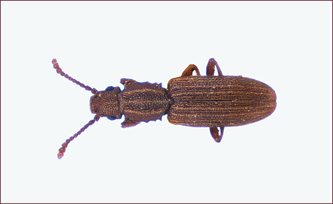
Like confused flour beetles, sawtoothed grain beetles, Oryazephilus surinamensis, attack flour and other processed grain products, as well as many other types of dried foods. Sawtoothed grain beetles are about 1/10 inch, flat-bodied beetles that have a series of saw-like teeth along each side of the thorax. The merchant green beetle, Oryazephilus mercator, is a closely related species that looks similar to the sawtoothed grain beetle.
Lesser Grain Borer
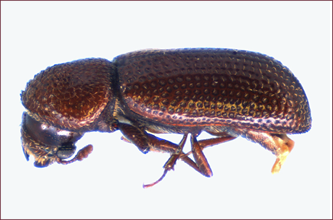
Lesser grain borers, Rhyzopertha dominica, are dark brown, cylindrical beetles that bore into whole grains such as wheat, buckwheat, or corn. Adults are about 1/10 inch. The small, legless larvae develop inside individual grains. Infested grain has small holes and contains large amounts of flour from their boring.
Rice Weevil
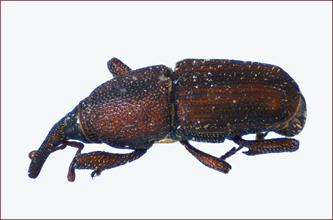
Rice weevil, Sitophilus oryzae, and its sister species, the maize weevil, attack whole grains such as corn, wheat, or rice. They use their long snout to bore a tiny hole into individual grains and lay an egg inside. The small, legless grubs eat the insides of the grain, pupate inside the hollowed shell, and then emerge as adults. Adults are about 1/16 inch.
Bean Weevil and Cowpea Weevil
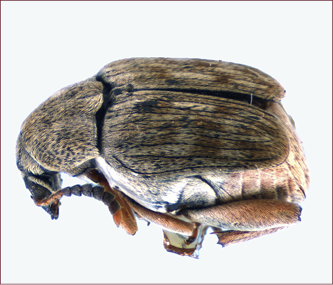
Peas and other dried legumes are subject to attack by pea weevils or bean weevils. The adults are about 1/8 inch, broad-bodied, wedge-shaped beetles with wing covers that do not reach the tip of the abdomen. These are not true weevils; they do not have a distinct snout like rice weevils. The legless larvae develop by feeding inside individual seeds, and the adults chew holes in the side of the seed to emerge. Because these insects attack only legumes, infestations do not spread to other types of food products.
Drugstore Beetle
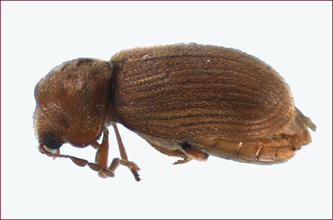
Drugstore beetles, Stegobium paniceum, are about 1/10 inch, stout-bodied, tan-colored beetles that attack many different types of food products; dry dog food seems to be the most commonly infested product. They also occur in dried herbs, such as red pepper or paprika, as well as spices and other dried plant products, including tobacco products, tea, flour, cereals, birdseed, old rat bait, and many other dried plant or animal-based products. Caches of seeds or nuts stored in wall voids by squirrels or rats can support heavy infestations, and it is usually difficult to determine the source of these types of infestations. The white, grub-like larvae feed on or in the infested products.
Cigarette Beetle
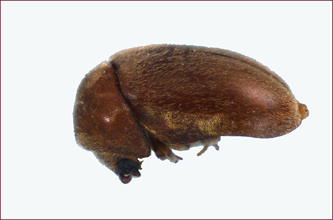
As the name implies, the cigarette beetle, Lasioderma serricorne, is an important pest of tobacco products. In the home, it is more likely to occur in other types of stored products such as dried plants or flowers, herbs, spices, flour and other grain products, upholstery of antique furniture, and many other dry plant products. Adult cigarette beetles are about 1/10 inch and dark tan. They superficially resemble drugstore beetles, though key characteristics distinguish the two species. The larvae are small, white grubs.
Controlling Stored Food Pests
Controlling stored food pests can be as simple as discarding the infested food product as soon as you discover the pests. But don't just drop them into the garbage can under the kitchen sink; get them completely out of the house before they have a chance to spread. If the infestation is recent and if other susceptible products are properly stored, this may be the end of the problem, although it is still a good idea to check other food items stored in the area to see if they are infested. Check any opened packages especially carefully, and keep in mind that, although you may find adult moths in the top of the package, most stored food pests and the signs of infestation tend to be concentrated in the bottom of the package or container. More extensive infestations require more effort, as described in Controlling Heavy Infestations below.
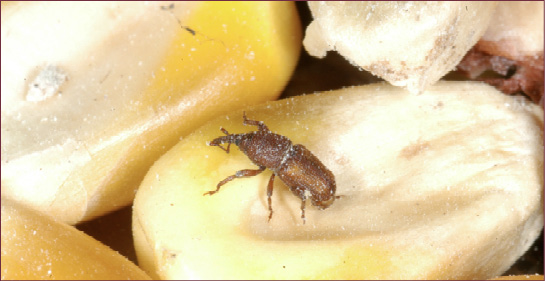
Moth Pests
Seeing small moths flying about is often the first warning that you have a caterpillar infestation in some of your stored food items. Although many non-pest moth species occur inside homes, small moths (less than ½ inch long) you routinely see flying about the house, rather than concentrating in windows or around lights, are likely to be stored food pests. Catch some and send them in for identification if you want to be sure. In this case, the solution is to find the infested products and discard them; then be sure any uninfested susceptible products are stored in bug-proof containers.
As you begin your search, keep in mind that moths may emerge from the infested product and fly to any room in the house. Still, begin your search in the area or room where you see the most moths. Before beginning to search, take a few minutes to think about what types of susceptible products are stored in the area. Bags of birdseed, sacks of dried peanuts, ears of ornamental corn, and cereal-based bath flakes are just a few examples of the types of items that support infestations of moths, as well as other insects, and are often stored in areas of the house other than the kitchen. Of course, many infestations occur in the kitchen.
Systematically check every susceptible product for signs of infestation. These include “dust,” holes bored into containers (this is done by the mature caterpillars as they leave in search of a place to build their cocoons), holes or tunneling in food items, silk webbing, and presence of caterpillars. If you find an infested product in an area, it is a good idea to double-check all the other products stored in that area. Make sure susceptible products are stored in bug-proof glass or plastic containers.
Beetle Pests
Although many of the beetles that attack stored foods are strong fliers, you usually see them in or near the infested product. But beetle infestations can spread quickly, so if you encounter a heavy infestation anywhere, check all susceptible products in the house.
Be sure of your identification. Beetles inside containers of stored food are obviously stored food pests, but many beetles occur in homes that do not attack stored foods. Many of these are harmless occasional invaders, but some may be wood-boring beetles that attack furniture or structural lumber, or others that feed on mold growing on moist wood or plaster. If you routinely find small beetles inside the home but can't trace them to a stored food source, collect some, preserve them in alcohol, and submit them for identification.
Controlling Heavy Infestations
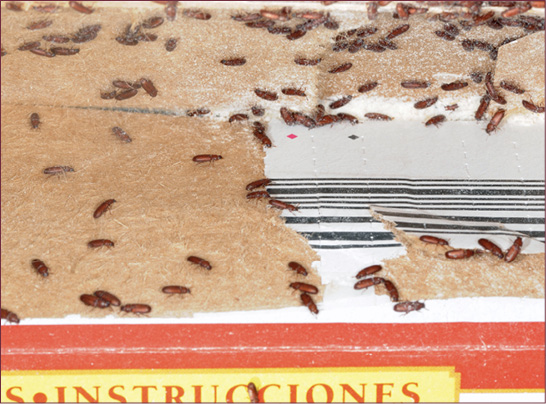
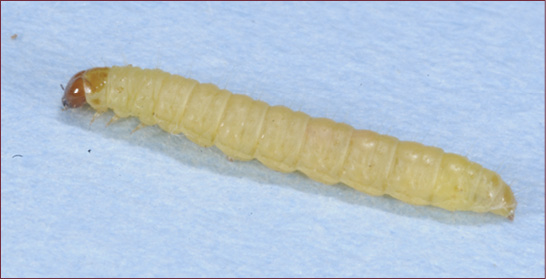
It takes a well-planned, systematic effort to control heavy infestations of stored food pests. If the infestation is in the kitchen, remove all food items from the pantry and/or cupboards, and thoroughly clean and vacuum any spilled food. Be sure to clean cracks and crevices, because many of the smaller beetles can hide in these areas and develop on crumbs and flour that accumulate there.
Mature caterpillars tend to wander in search of a place to pupate and often chew through the wrapping of the product where they developed. Thorough cleaning and vacuuming also help remove these wandering caterpillars and their resulting cocoons. Don't forget to check for cocoons at the juncture of walls and ceilings or on the undersides of shelves where they meet a wall. Be sure to empty the contents of the vacuum, and discard them outside the house immediately after cleaning; otherwise, the insects can breed inside the vacuum and reinfest.
If you want to treat with an insecticide, do it while the pantry or cabinet is empty, and let the spray dry before restocking food items. But if you do a thorough job of sanitation, it is not necessary to use insecticides, and insecticides are not an effective substitute for thorough cleaning and storing products in bug-proof containers. If you use an insecticide, read the label carefully before buying the product to be sure it is specifically labeled for use in and around food-storage areas. Several products containing active ingredients such as cyfluthrin or permethrin are labeled for this use and provide long-term residual control on treated surfaces. Some products containing natural pyrethrum (pyrethrins) are also labeled for this use, but these provide very little residual control. Directed crack and crevice sprays are more effective than other types of treatment, such as aerosol foggers.
Stored food pests can be anywhere in the house. Don't restrict your search to the kitchen. Infestations of stored food insects can occur anywhere in the house that there is a suitable, exposed food product. When you find heavy infestations of stored food insects in one area of the house, there is a good chance they have spread to other susceptible products in other areas, as well. These are some nonkitchen situations where infestations are commonly found:
- dry pet food
- camping/hunting gear (trail mix, peanuts)
- packets of rat bait
- rodent caches (nuts or pet food stashed in wall voids)
- decorative ears of corn
- dried flower arrangements
- birdseed
- dried nuts (especially peanuts, pistachios, or almonds)
- cereal-based bath flakes
- grain stored in bulk (corn, wheat, spelt)
- candy bars
- stuffed animals/pin cushions (if stuffed with grain or beans)
- food in pockets of clothes
- bean bags (stuffed with beans or grain)
- tobacco products
- dried seed mosaics or displays
Preventing Infestations of Stored Food Pests
Prevention is the best defense against stored food pests. Store susceptible products in insect-proof glass or plastic containers, especially after you have opened the original container. You can also protect foods from infestation by storing them in a freezer or refrigerator; many people protect especially susceptible products such as flour or cornmeal by storing them this way. Because susceptible food items are more likely to become infested the longer they are stored, practicing good stock rotation can help. Eat it before the bugs do!
Freezing is also an effective way to control most stored food insects. If you suspect a susceptible food product may have been exposed to attack but there are no signs of infestation, place it in a deep freezer (at 0°F or lower) for a week or more. This kills eggs and newly hatched larvae of most stored food pests.
Large bulk quantities of whole grains such as wheat, spelt, or corn are highly susceptible to infestations of stored food pests, but if you store them properly, you can successfully keep them for years. Freezing or refrigeration is one way to protect bulk grains, but it is often not practical because of space considerations. Also, condensation occurs as the grain thaws and can cause mold. Storing bulk grain in insect-proof containers effectively prevents infestation, but any insects already in the grain when you put it in storage thrive.
Treating bulk grain with food-grade diatomaceous earth and storing it in insect-proof containers is one of the most effective ways to obtain long-term protection from insect pests. Be sure to purchase food-grade diatomaceous earth that is specifically labeled for this use, and follow label directions. Food-grade diatomaceous earth is safe for human consumption when used as directed, but inhaling the dust can cause respiratory problems, so wear protective equipment. You can buy food-grade diatomaceous earth from mail and Internet suppliers. Follow directions for use.
Spiders
Spiders are frequent home invaders. Although spiders prey on insects, most homeowners consider them unwelcome pests. Most spiders produce venom and can bite, but only three Mississippi species, the black widow, the brown widow, and the brown recluse, are seriously venomous to humans. Symptoms associated with the bites of most other spiders range from not noticeable to a small, short-lived pinprick to localized pain and swelling similar to a wasp or bee sting. Some of the spiders most commonly found inside Mississippi homes are briefly discussed here.
American House Spider
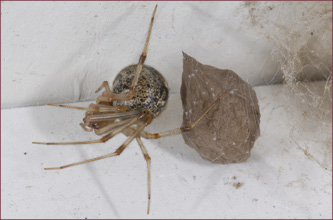
American house spiders, Achaeranea tepidariorum, are the small, brown, globe-shaped spiders that build their unsightly cobwebs in the upper corners of garages, windows, and infrequently used rooms. Although they are one of the most commonly encountered spiders in the state, they go largely unnoticed, primarily because they are so common. These spiders belong to the same family as the black widow, but they are not venomous and rarely bite humans. Still, they are nuisances because of their unsightly webs. Because of their color and general body shape, common house spiders might be mistaken for brown widows, but they do not have an orange hourglass shape on the underside of the belly.
Southern House Spider
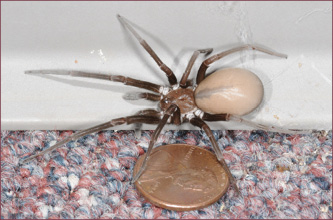
Southern house spiders, Kukulcania hibernalis, are relatively large spiders, up to 3/4 inch excluding the legs, that build small, funnel-like webs in cracks and crevices. They occur in basements, closets, barns, storage rooms, and other areas where items are stacked and stored for a long time. The females have robust, dark brown bodies and legs, but the area where each leg joins the body is silver. The males look much different. They are light brown, long-legged, and slender-bodied and are often mistaken for brown recluse spiders. These spiders occasionally seek refuge in coats and other articles of clothing not worn for some time. They can give a painful bite when trapped against the skin.
Wolf Spider
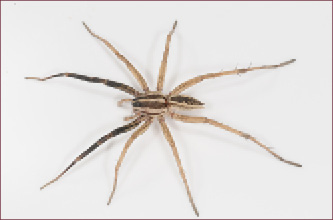
Wolf spiders, Lycosa spp., are ground-inhabiting spiders that do not build webs but wander about on the ground in search of prey. They are relatively large spiders, up to 3/4 inch excluding the legs. Although they do not normally live inside, they often wander into garages or houses, where they usually attract attention because of their size. The most commonly encountered species is tan with dark brown longitudinal stripes on the back. Female spiders carry their large, round egg sacs attached to their abdomens, and newly hatched spiderlings ride about on the back of the female. Females carrying newly hatched spiderlings appear much larger than they really are. These spiders can produce a sharp, pinprick-like bite when trapped against the skin, but they are not aggressive.
Jumping Spider
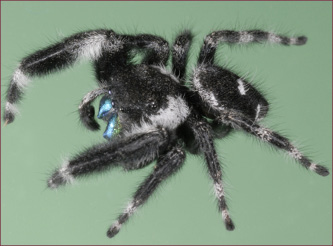
There are many species of jumping spiders, Phidippus spp. One of our most commonly encountered species, the bold jumping spider, is black and white and about 1/2 inch long. These spiders do not use webs to catch a meal but stalk their prey and then jump forward to capture it. Unlike most spiders, they prefer to hunt during the day in well-lit areas. They do not normally live inside but frequently wander into homes. They can bite, and bites can cause local swelling and even local tissue necrosis, but they are usually not aggressive.
Cellar Spider
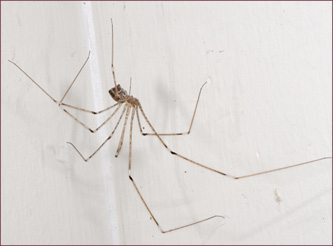
As the name suggests, cellar spiders (family Pholcidae) live in cellars, basements, garages, sheds, stairwells, crawl spaces, and other dark, cool locations. These nonvenomous spiders are sometimes found in heated and cooled living areas. There are several species, but the long-bodied cellar spider, Pholcus phalangioides, is the most common. Cellar spiders have unusually long legs and are referred to as “daddy longlegs spiders” in some parts of the country, a name that is more commonly applied to harvestmen in the South. Cellar spiders spend most of their time hanging upside down in their large, irregular-shaped webs. When disturbed, they usually bounce up and down rapidly on the web. Females carry the round, translucent egg sacs in their fangs.
Spitting Spider
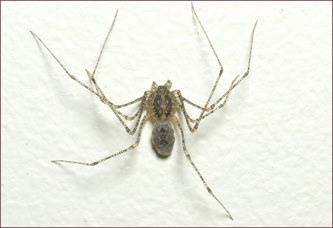
Sitting spiders, Scytodes spp., are often encountered in homes, especially in closets and other dark, relatively undisturbed areas. They do not build webs but slowly stalk their prey and capture it by spitting their glue-like venom onto it. Mature spitting spiders are about 1/3 inch long excluding their long, thin legs, and are light brown with dark, writing-like markings. Like brown recluse spiders, they have only six eyes, arranged in three pairs.
Brown Recluse
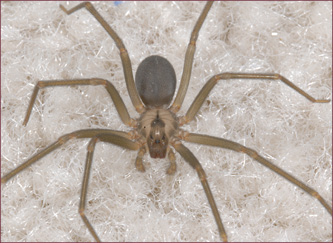
Brown recluse spiders, Loxosceles reclusa, are sometimes referred to as “fiddle-back” or “violin” spiders because of the distinct, dark, fiddle-like shape on the front portion of their backs. Most spiders have eight eyes, but brown recluses have only six, grouped into three pairs. Although brown recluses may live outside, they are common in homes, where they build their irregular webs in cracks and crevices in undisturbed areas, and some homes can harbor heavy infestations. Brown recluses often live in basements, attics, storerooms, or closets. They often hide in crevices created by the folds of infrequently used coats, bedding, or other clothing, and bites often occur when such items are worn without first checking for spiders.
Although there seems to be considerable variability in individual response to bites, brown recluse bites can be quite serious, resulting in extensive localized tissue damage. The bite itself is not especially painful and may initially go unnoticed, but the venom causes localized tissue death, which may slowly spread from the point of the bite. Because early treatment can lessen the effects of a bite, seek immediate medical attention if you think you have been bitten by a brown recluse. When possible, it is helpful to capture the spider that caused the bite so that it can be positively identified. See Extension Publication 2154 Spiders: Brown Recluse and Black Widow for additional information.
Black and Brown Widows
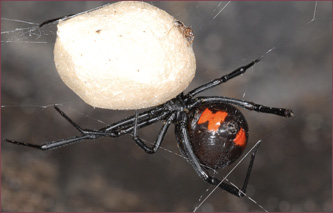
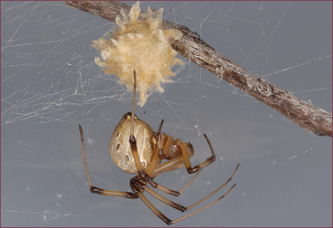
You can easily identify a female black widow, Latrodectus mactans, by the distinct red, hourglass shape on the usually black, shiny abdomen. There are exceptions; some specimens can be brown, and some specimens may have additional red spots on their abdomens. You don't often find black widows indoors, but they are common in outdoor areas around the home. They nest in dark, secluded areas near the ground, such as piles of wood or refuse, under steps or crawl spaces, in water meter boxes, and under infrequently used items. The web is made of strong strands of silk that are rather indistinctly organized. A smooth, tan egg sac is often present in the web. Indoor infestations most often occur in garages, storerooms, or basements.
The brown widow, Latrodectus geometricus, is a related species that has recently become established in Mississippi. Brown widows have an orange hourglass shape on the underside of the abdomen and are similar to black widows in size and body shape. Their abdomens are tan with white markings, and their legs are light brown with dark brown bands. Brown widows are often mistaken for American house spiders, and vice versa, because their nesting habits are similar. Within their area of occurrence, brown widows are more likely to be found in and around homes than black widows. Their egg sacs are covered with spikes of silk so that they resemble a ball from a sweet gum tree. These spiky egg sacs are a distinctive, identifying feature of brown widows.
Seek immediate medical attention if you get bitten by a widow spider. Fatalities from widow spider bites are extremely rare, especially with good medical attention, but the venom of widow spiders is neurotoxic and can result in intense pain and cramping of muscles, especially in the abdomen and upper legs. Symptoms of brown widow bites tend to be milder and more localized than those of black widow bites. When it is possible to quickly and safely do so, capture the spider for identification. This will help medical personnel with treatment decisions.
See Extension Publication 2154 Spiders: Brown Recluse and Black Widow for additional information about black widows.
Harvestman
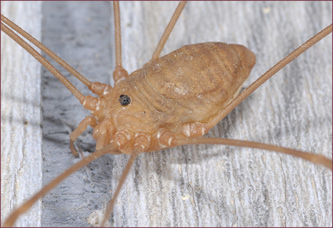
Also known as “daddy long legs,” harvestmen (many species in the order Opiliones) are not true spiders. They are easy to identify by their long, thread-like legs and their small, oval bodies. Harvestmen seldom occur indoors but are often seen around the outside of the house, occasionally clustering in large numbers under the eaves or in some other protected location. They forage on dead insects and other decaying organic matter. Contrary to common urban mythology, they are not venomous, but they do produce an unpleasant odor when disturbed.
Spider Control
Controlling outdoor spiders, such as wolf spiders and jumping spiders, that occasionally wander indoors can be as simple as catching or crushing and discarding the invader. It takes a lot more work to control a heavy infestation of indoor-dwelling spiders, such as brown recluses or American house spiders. Exclusion and sanitation are the most important steps in spider management. Insecticides can be useful in certain situations.
Exclusion
Keep screens on windows and over vents in soffits, gables, and crawl spaces; use weather stripping and door sweeps, and take other precautions to make the house as bug-tight as possible. This helps keep out spiders as well as insects. Because indoor spiders such as American house spiders and brown recluses prey on insects that get inside the house, anything you do to exclude insects will also help reduce spider populations. Exterior lighting attracts many night-flying insects. This, in turn, attracts spiders, which like to build their webs near such an abundant supply of prey. In addition to keeping exterior lights turned off when not needed, you can reduce the number of insects attracted to exterior lighting by using yellow bug lights or sodium vapor lights, rather than mercury vapor lights.
Sanitation
Sweeping cobwebs out of the corners of garages, windows, and rooms is an effective way to remove the cobwebs, but the spiders that built them often escape and promptly build more webs. Use a vacuum to remove the webs and the spiders that built them. Spiders such as brown recluses and southern house spiders like to nest in dark, undisturbed storage areas. Keep such areas clean and well organized to discourage spiders. Store items, especially cloth items, in insect-tight plastic containers rather than cardboard boxes.
Sanitation is the critical first step in controlling heavy infestations of brown recluses, southern house spiders, and other spiders that infest indoor storage areas. Systematically remove boxes and other items from the storage area, checking for spiders as you do so. Be sure to check inside storage boxes as you remove them, especially those with holes through which spiders could enter. Keep a vacuum and/or a can of an appropriate indoor insecticide spray handy to deal with any spiders you find. Once you have removed all boxes and items from the area, sweep and/or vacuum thoroughly. Be especially sure to vacuum corners, cracks, and crevices where spiders might hide. After you have emptied and cleaned the storage area, treat with an appropriately labeled residual insecticide before replacing the stored items.
Because brown recluses often hide and nest in the folds of infrequently used clothing and bedding, it is wise to check such items carefully before using them for the first time after a long period of storage. This could keep you from getting bitten by a spider that has been living in that coat in the basement since last winter or the sleeping bag that has been stored in the attic since the last camping trip.
Traps
Several companies sell sticky glue traps you can place along walls to capture spiders and other crawling insects. Such traps are not especially useful in controlling a heavy spider infestation, but they can help determine the level of infestation and which species are present.
Insecticides
Use insecticides containing active ingredients such as cyfluthrin, cypermethrin, deltamethrin, lambda-cyhalothrin, permethrin, tralomethrin, or even pyrethrins (pyrethrum) to control spiders you can spray directly. Pyrethrins do not provide residual control, but products containing the other active ingredients provide relatively long residual control, especially when applied indoors where they are not exposed to sunlight. Apply these products to voids, cracks, crevices, and baseboards to control spiders such as brown recluses that live in closets and other storage areas, or apply as spot sprays to control spiders such as American house spiders that nest in corners of windows, basements, garages, and such. Be sure to read and follow all label directions.
Insecticides formulated as wettable powders or micro-encapsulated products typically provide better residual spider control than ready-to-use formulations but can be difficult to find in packages labeled for homeowner use. Demon WP (cypermethrin) is one example of a wettable powder insecticide that pest-control companies often use for spider control. Wettable powder products must be diluted in water and applied using a hand pump sprayer.
Some of the other active ingredients mentioned are available as liquid concentrate sprays, which must also be mixed with water and applied using a hand pump sprayer. Many of these active ingredients are also available in ready-to-use sprays that are prediluted and sold in trigger-pump sprayers. These ready-to-use sprays or aerosol sprays are a convenient way to treat limited infestations and are the most common formulation offered to homeowners for use indoors. Many insecticides are also formulated and sold as total release aerosol foggers, but these are less effective than sprays you can direct into cracks, crevices, and voids.
Where spiders such as brown recluses are nesting in wall voids, other voids, or deep cracks and crevices, dusts containing the active ingredient deltamethrin can be especially useful. Drill small holes into voids, and use a specially designed bulb duster to inject small amounts of dust into such voids and cracks and crevices. Dusts containing 0.05 percent deltamethrin are readily available at local retailers, but you may have to specially order bulb dusters.
Because professional pest-control companies have access to an array of effective insecticides and the equipment to apply them properly and safely, many homeowners rely on professionals to control heavy spider infestations. If you hire a pest-control company, you still need to work with the technician. They may need you to remove boxes and other items from storage areas and other areas to be treated and to check for spiders inside boxes before applying the treatment.
Table 5. Indoor treatments for spider control.
|
Formulation |
Active Ingredient |
Brand Name (examples) |
|
ready-to-use |
bifenthrin (0.05%) |
Ortho Home Defense Max |
|
cyfluthrin (0.05%) |
BioAdvanced Complete Insect Killer |
|
|
deltamethrin (0.02%) |
Bonide Household Insect Control |
|
|
deltamethrin (0.03%) |
Raid Max Bug Barrier |
|
|
gamma-cyhalothrin (0.025%) |
Spectracide Bug Stop Home Barrier |
|
|
permethrin (0.25%) |
Viper RTU |
|
|
dust |
deltamethrin (0.05%) |
Terro Ant Dust |
|
deltamethrin (0.05%) |
D-Fense Dust |
|
|
deltamethrin (0.05%) |
Deltadust |
Asian Lady Beetles
.jpg)
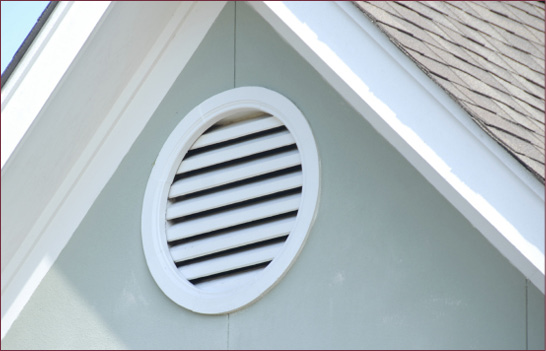
We have more than 100 native species of lady beetles in the state. Most are beneficial because they eat aphids, whiteflies, small caterpillars, and other insect pests. The multi-colored Asian lady beetle, Harmonia axyridis, is a nonnative species that specializes in preying on tree-dwelling aphids. During most of the year they are considered “good bugs,” but as cold weather approaches, they start looking for a place to spend the winter, and this is when they can become real pests.
In their native eastern Asia, these lady beetles congregate in light-colored rocky outcrops, where they overwinter in cracks and crevices among the rocks. Here in Mississippi, we do not have many rocky outcrops, but buildings seem to make a fine substitute. They are especially attracted to buildings with an unshaded western or southern exposure. Once the lady beetles land on the side of the building, they crawl into cracks and crevices. This results in their entry directly into living quarters or into wall voids and attics where they often congregate in large numbers to spend the winter. As temperatures warm in the spring, or during warm periods during the winter, beetles overwintering in attics and wall voids begin to search for cracks and crevices through which to leave. Many of these beetles “get lost” and find their way into the inside of the building rather than the outside.
Whether they invade the home in the fall, during warm spells in winter, or during the spring as they attempt to leave their overwintering quarters, these otherwise beneficial insects can become serious nuisances, especially when they occur in large numbers. They can cause small stains on walls and wall coverings, and some people are allergic to the dust from the dried, crushed bodies of dead beetles. The best way to avoid these problems is to prevent the lady beetles from entering the home in the first place, which means you must make the exterior of the home bug-tight before these insects start looking for a place to spend the winter.
The key is to seal or screen any opening greater than 1/16 inch in diameter. This is easier to do on some homes than others. Homes that have overlapping board-type siding nailed directly to the wall studs, without any type of solid wallboard in between, are especially problematic because there can be literally hundreds of feet of potential entry points. But on many homes, it is relatively easy to identify and seal potential entry points, and taking the time to do so before fall can prevent much frustration later in the winter.
Once beetles get inside the living quarters, the best way to deal with them is to use a vacuum. In heavily infested houses, this can become an annoying, winter-long task. Insecticides are not much use at this point. It is neither safe nor practical to treat the entire room with insecticide, and you would still have to collect and discard the dead lady beetles.
Lady Beetle Control
A good defense is the best offense when dealing with lady beetles.
Exclusion
Keep them from getting inside the house in the first place. Doors and windows are obvious potential points of entry. Install sweeps on door bottoms and metal spring strips or weather stripping around door jambs to keep lady beetles from entering at these points. Use caulking or foam sealant to seal entry points around plumbing and conduit and cracks in brickwork and woodwork.
Check all attic, roof, gable, and soffit vents to be sure that they are adequately screened and bug-tight. Unscreened soffit vents can be a prime point of entry, but lady beetles can also enter around screened soffit vents if they do not fit tightly against the soffit. Many homes have ridge vents or other types of vents on the roof through which large numbers of beetles and other insects can enter if they are not properly screened. Be especially sure to properly screen the large gable vents that are located on the ends of many houses. Obviously, each house has its own unique set of potential entry points, and each house must be considered on a case-by-case basis.
You must finish exterior screening and sealing before the beetles enter the attic and/or wall voids. Depending on location and weather conditions, lady beetles normally begin searching for overwintering sites between mid-October and mid-November. Don't wait until the last minute. Try to get this done before the first of October. Wait too late—after the beetles have already gotten in—and you only make matters worse, by trapping the beetles inside attics and wall voids and forcing them into the interior of the building.
You can seal cracks and entry points on the interior side of the wall and ceiling anytime. Even if the beetles have already gotten into your attic and/or wall voids, you may still be able to keep them from getting into your living area. Seal around electrical outlets, light fixtures, and other holes in interior walls and ceilings. Remember, any hole or crack bigger than 1/16 inch across is large enough for a lady beetle to get through. You can also seal around doors and windows that open directly to the outside at any time of the year. The better you can seal the beetles out of your living area, the fewer you will have to vacuum. But don't overdo this sealing effort; be sure to maintain adequate ventilation for health and safety.
Insecticide Treatments
Insecticides are not especially useful for controlling invasions of Asian lady beetles once they are inside. But you can apply residual sprays of synthetic pyrethroid insecticides to exterior areas of invasion-prone buildings to reduce the number of beetles that successfully enter the building. Such treatments are most beneficial on buildings that have so many potential entry points you can't effectively seal them. Where sealing is practical, it is far more effective than relying on insecticides, and it can also conserve energy. Pyrethoid insecticides labeled for use as residual sprays to the outside of homes include permethrin, cyfluthrin, deltamethrin, lambda-cyhalothrin, and bifenthrin. Several of these insecticides are available for use by homeowners, but you can also have these treatments applied by a licensed pest-control company. Always read and follow label directions. Especially note restrictions on application of pyrethroids over nonporous surfaces (such as asphalt and concrete) and limitations on where pyrethroids can be applied to building exteriors. Spot treatments are defined as areas of 2 square feet or less.
Table 6. Residual surface sprays for control of lady beetles around the outside of homes.
|
Formulation |
Active Ingredient |
Brand Name (Examples) |
|
ready-to-use |
bifenthrin (0.05%) |
Ortho Home Defense Max |
|
cyfluthrin (0.05%) |
BioAdvanced Complete Insect Killer |
|
|
deltamethrin (0.02%) |
Bonide Household Insect Control |
|
|
gamma-cyhalothrin (0.025%) |
Spectracide Bug Stop Home Barrier |
|
|
permethrin (0.25%) |
Viper RTU |
|
|
concentrate1 |
bifenthrin (0.3%) + cypermethrin (0.075%) |
Ortho Home Defense Insect Killer Concentrate |
|
beta-cyfluthrin (0.36%) + imidacloprid (0.72%) |
Bioadvanced Complete Insect Killer |
|
|
zeta-cypermethrin (0.35%) |
GardenTech Sevin Insect Killer Concentrate |
|
|
gamma-cyhalothrin (0.08%) |
Spectracide Triazicide Insect Killer Concentrate |
|
|
permethrin (10%) |
Hi-Yield Garden, Pet, & Livestock Insect Control |
1Concentrates must be diluted with water before they are applied. Read labels carefully and note restrictions on where products may be applied to building exteriors. Spot treatments are defined as areas of 2 square feet or less.
Occasional Invaders
There are many species of insects, spiders, and other arthropods that wander into the house occasionally. They don't necessarily want to be indoors; they just happen to get trapped there, usually because there was a big enough crack under the door or some other entry point for them to get through. Ground beetles, earwigs, crickets, and millipedes are common home invaders, as are several species of spiders. Because wolf spiders (family Lycosidae) wander about on the ground in search of prey, they are some of the most common home-invading spiders.
.jpg)
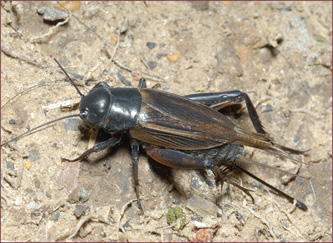
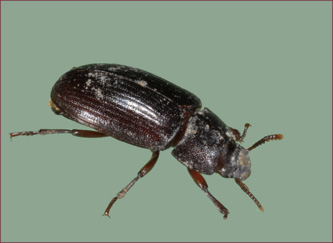
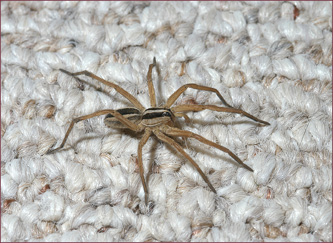
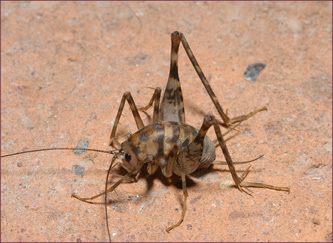
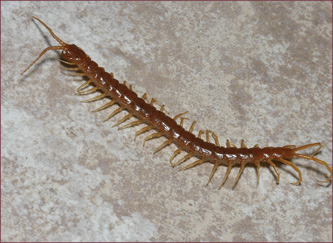
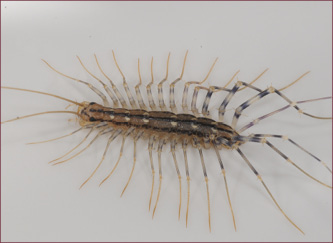
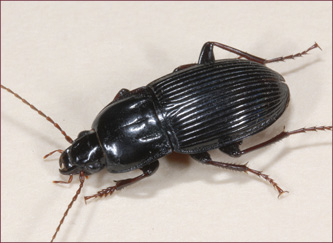
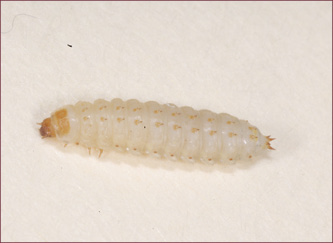
Occasional Invader Control
Exclusion
Exclusion is the best way to prevent these pests. Be sure doors have weather stripping or spring steel strips around the edges and sweeps that fit tightly against the threshold. Make sure windows have properly fitting screens, and seal other potential entry points.
Be aware that lights located over or near an entry can attract large numbers of insects, which can then enter the building as you come and go. Shielding or shading lights so that most of the light is directed down rather than out into the night reduces the number of insects drawn to the area. Using yellow “bug bulbs” or sodium vapor bulbs that produce wavelengths of light that are less attractive to insects reduces attraction even further.
You can use ready-to-use insecticide sprays or aerosol sprays to control insect pests that do get indoors. Most of the ready-to-use sprays can also be sprayed around doorways and windows to help prevent pests from getting inside. Read the label for specific instructions.
Outdoor Perimeter Treatments
Occasionally a particular pest is unusually abundant around the outside of the house, resulting in an excessive number of invasions. Sometimes there can be so many, they become a real nuisance. This often happens with crickets or millipedes when environmental conditions result in population explosions or mass migrations, and it sometimes happens with other species.
In such cases, outdoor perimeter sprays can be helpful in controlling pests before they get inside. Usually, you apply these perimeter sprays to a band of ground (mulch, turf, bare soil, under shrubs, and such) around the outer wall of the house. Depending on the label, they may also be applied to the lower portion of the outer wall of the house and outside around doors and windows. Many of these products are sold primarily for use in and around the home lawn and are not approved for indoor use. Most are insecticide concentrates you must dilute in water and apply as liquid sprays. Some are sold in ready-to-use hose-end applicators. Read the label for full use instructions.
Table 7. Ready-to-use insecticide treatments for control of home-invading insects and spiders.
|
Active Ingredient |
Brand Name (Examples) |
|
bifenthrin (0.05%) + zeta-cypermethrin (0.0125%) |
Ortho Home Defense Insect Killer |
|
cyfluthrin (0.05%) |
BioAdvanced Complete Insect Killer |
|
deltamethrin (0.02%) |
Bonide Household Insect Control |
|
gamma-cyhalothrin (0.025%) |
Spectracide Bug Stop Home Barrier |
|
permethrin (0.25%) |
Viper RTU |
Table 8. Outdoor perimeter sprays for control of home-invading insects and spiders.
|
Active Ingredient |
Brand Name (Example) |
|
bifenthrin (0.3%) |
Ortho Home Defense Ready-to-Spray |
|
bifenthrin (0.3%) + zeta-cypermethrin (0.075%) |
Ortho BugClear Ready-to-Spray |
|
bifenthrin (2.4%) |
Hi-Yield Bug Blaster Ready-to-Spray |
|
beta-cyfluthrin (0.36%) + imidacloprid (0.72%) |
Bioadvanced Complete Insect Killer |
|
zeta-cypermethrin (0.35%) |
GardenTech Sevin Insect Killer Concentrate |
|
gamma-cyhalothrin (0.08%) |
Spectracide Triazicide Insect Killer Concentrate |
|
permethrin (10%) |
Hi-Yield Garden, Pet, & Livestock Insect Control |
|
permethrin (38%) |
Hi-Yield 38 Plus, Turf, Termite, & Ornamental |
Millipedes
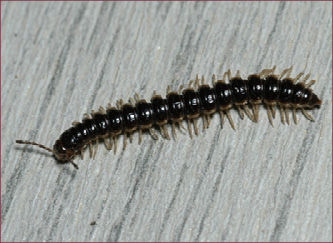
Prolonged wet weather during the warmer months of the year often results in increased movement of greenhouse millipedes, Oxidus gracilis, also known as garden millipedes. Although these arthropods are harmless to people, pets, and plants, they can be a significant nuisance when they occur in large, persistent numbers.
Millipedes feed on decaying organic matter, such as leaf litter, grass thatch, and flower bed mulch. They live in moist leaf litter, under logs, under bark of decaying stumps, and in similar situations. In favorable habitats, they can be present by the thousands, but they are rarely seen in dry weather because they can't move about when it is dry (unless they are trying to migrate to a moisture source when their original location becomes too dry). Millipedes do most of their wandering at night and seek refuge in moist, dark, protected sites during the day.
Despite their hard bodies, millipedes do not conserve moisture very well. This is why they are only active during wet, rainy weather and why they die quickly, whether sprayed with insecticide or not, when they get indoors, where air is usually drier.
Millipede Management
Establish and maintain good exclusion around the building. This includes attention to thresholds, door sweeps, door and window seals, structural cracks, and so forth. Sealing such cracks will also help keep out other occasional insect invaders and will help conserve energy. Physical exclusion is the most effective thing home and business owners can do to reduce the number of millipedes—and other insect pests—that invade the building.
Use a broom and dustpan or good wet/dry vacuum or leaf blower to keep dead and dying millipedes cleared off the carport, garage, patio, and floor. This takes persistence and patience but is the best way to avoid having to deal with thousands of dead millipedes crunching under foot. Millipedes are going to die quickly once they find themselves in these relatively dry environments. Insecticide sprays do not kill them much faster in these situations, and, whether they die of desiccation or insecticide poisoning, you still have to sweep or vacuum them up.
Use cultural practices that help minimize the amount of mulch, leaf litter, and grass thatch around the house. Of course, this must be done before the problem begins. People who have a persistent or recurring problem may want to try to figure out where the millipedes are coming from and take steps to remove or minimize their breeding source. This can be excessive flower bed mulch, accumulations of leaf litter, dethatching the lawn, and so forth. Houses that have the greatest problems are often located in wooded settings, which results in large numbers of millipedes migrating from leaf litter in the woods. This is one of the most difficult situations to deal with effectively because there is such a large breeding source and millipedes will continue to migrate from these sources as long as weather conditions allow.
Correct drainage and moisture problems around the immediate exterior of buildings and in interior situations that result in the kind of prolonged moist conditions that allow millipedes to survive—things like leaky or flooded basements, water accumulation in carports, and water pooling against building foundations or under decks. Millipede problems can persist even after dry weather returns if they find themselves in moist basements or carports or moist, wet areas around building perimeters. This type of moisture/water management is important for termite control, as well.
Insecticides are not really very helpful when dealing with millipedes. The problem is that, even if you kill all the millipedes that arrive at the house, more just keep coming back—as long as they have the kind of moist, humid weather that lets them wander about in the open at night. Excessive use of insecticides can create an even worse problem, one that will not go away on its own with the arrival of dry weather! It is usually better to spend your time and money on exclusion and source reduction than on spraying.
Applying an outside perimeter spray in a 5- to 10-foot band around the outside of the building may be somewhat helpful in some situations, but it will not be a total fix. The goal is to kill the millipedes before they move farther inside. Such treatments can also be useful for reducing millipedes harboring under low decks and similar protected exterior situations. See Table 8 for examples of products that can be used in this way.
Dry weather is the ultimate cure for garden millipede problems. Millipedes are so sensitive to desiccation that they just can't travel far from their natural homes when it is dry.
Scorpions
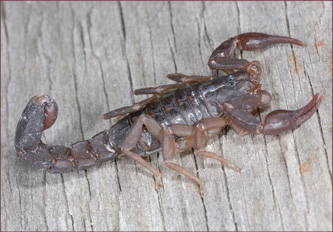
Scorpions are not common in Mississippi, but they do occur. The southern devil scorpion, Vaejovis carolinianus, is a native species that occurs primarily in the northeast portion of the state, especially in counties bordering Tennessee and north Alabama. Even in these areas, scorpions are not common, and sightings usually involve only one or two specimens. Rarely, homes in this area will experience heavier infestations involving repeated, multiple encounters and even sting events. These are often associated with piles of firewood, lumber, stones, or other debris near the house.
The other species we sometimes see in Mississippi is the striped bark scorpion, Centruroides vittatus. Although this is the most common scorpion in the U.S., it is only rarely found in Mississippi, with most encounters involving only single individuals. Striped bark scorpions can appear anywhere in the state, and many of these sightings may be due to accidental transport.
Neither of these scorpions is very large. The southern devil scorpion pictured here is only about 1 inch long, but large individuals of either species can reach 3 inches. Both species can and will sting, and, although the sting is painful, it is very rarely deadly. Many folks who have been stung report only short-lived local pain with localized swelling, much like that caused by a wasp sting. Some have reported systemic effects, such as headaches, neck aches, and other symptoms.
Scorpions are active at night, when they leave their refuges to search for insects and spiders to eat. During the day, they remain hidden in cracks and crevices and beneath boards and stones.
Scorpion Control
Control should focus on exclusion and sanitation. First, make the house as “bug-tight” as possible by installing door seals, door sweeps, weather stripping, and so forth, and by caulking holes and cracks through which scorpions, spiders, or insects might enter. Then, eliminate any piles of debris or other areas where scorpions can hide outdoors around the house: stacks of wood or lumber, piles of bricks or stones, piles of plant debris, and similar refuges. When dealing with heavy infestations, bug-proofing the house before starting the clean-up process reduces the potential for displaced scorpions to enter the building.
For chemical control, use one of the insecticides listed in Table 8 to apply a perimeter treatment around the outside of the house (the ready-to-use, hose-end formulations are easy to apply). Read and follow label directions. Depending on what the label allows, treat a 5- to 10-foot border around the outside of the house and a couple of feet up the outside wall. These products can also be applied as exterior crack and crevice treatments, and such treatments can be especially helpful when scorpions have access to refuges that cannot be physically eliminated.
For indoor treatment, use one of the ready-to-use products listed in Table 7. Several brand-name products are available in trigger-pump spray bottles. See label directions for the types of places to apply these products. In general, spray around entryways, along baseboards, and behind and under furniture and appliances. Strategically placed sticky traps can also be useful, especially as survey tools to help gauge the effectiveness of other control efforts.
Paper Wasps
Paper wasps cause problems around homes or buildings in two ways. During the warmer months, they build their gray, inverted-umbrella-shaped nests under the eaves of buildings and in other protected locations. When their nest is disturbed or threatened, they are quick to defend it by stinging. Wasp stings hurt, and some people are highly sensitive to stings. In the cooler months, mated female paper wasps invade poorly sealed attics and buildings in search of a warm place to spend the winter. Although they are not nesting at this time and are not aggressive, they sometimes make their way into living areas, and stings can occur. Several species of paper wasps occur in the state.
Guinea wasps, Polistes exclamans, are small, yellow and brown wasps that build their nests in protected areas around buildings or equipment, as well as in dense shrubbery. Guinea wasps are often mistaken for yellowjackets, but yellowjackets are yellow and black and build their nests in the ground.
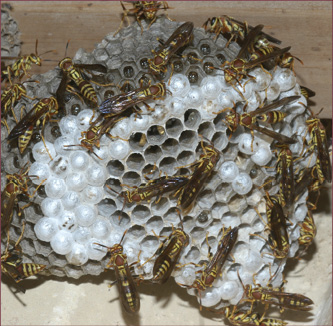
Red wasps are notably larger than Guinea wasps and are dark red and black. There are several species that fit this description, but Polisties metricus is the most common. Red wasp nests are similar to Guinea wasp nests but larger. In natural settings, nests are often built over water or in thick shrubbery, but around buildings they are built in the same places as Guinea wasp nests: under eaves and in other protected areas. Most people who have experienced both agree that red wasp stings are more painful than Guinea wasp stings.
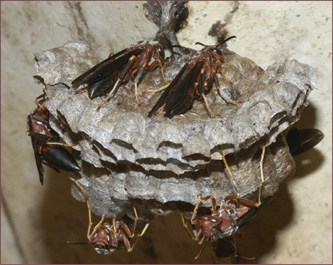
Carolina paper wasps, Polistes carolina, are large, orange wasps with black wings. They prefer to build their nests in enclosed, protected areas, such as inside eaves of buildings, but they have guards around the entrance to the nest area. These wasps are more aggressive than other species and may fly several feet to sting someone who happens to be near the nest site. Their sting is painful, arguably more painful than a red wasp sting.
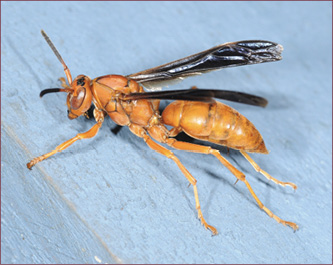
Regardless of species, paper wasp nests last only one season. The nest is abandoned in the fall after young female wasps are mated and leave to seek a place to spend the winter. In nature, they may overwinter in hollow trees, under loose bark of dead logs, and in similar protected areas, but they especially like to overwinter in attics and building voids if they can gain access to such areas. Poorly sealed attics can harbor large numbers of overwintering paper wasps, which may form clusters of several dozen or even hundreds, consisting of several species. When weather warms in the spring, these overwintered females leave their overwintering quarters to establish nests of their own.
Although most people think of wasps as harmful insects because of their stings, paper wasps are also beneficial. They are excellent predators of caterpillar pests. While bees collect pollen to provide protein for their young, paper wasps provide protein to their young by feeding them caterpillars.
Paper Wasp Control
Paper wasp nests that are built in the wrong place, where they are likely to cause stings, need to be eliminated—preferably proactively. Be alert for wasp nests around the home, and control them by spraying with an aerosol wasp and hornet spray. Such sprays are specially formulated to give quick-contact kill, which reduces the potential for stings. Note that some spray cans are designed to shoot a stream of spray up to 15 feet or more, which is best for nests that can be treated from that distance. Others produce a broader spray pattern that works best for nests that must be treated at closer range. Choose the right spray for the job and take necessary precautions to limit the potential for stings. Keep a can of wasp spray on hand so it will be handy when you find a nest that needs to be eliminated.
The only way to prevent large numbers of overwintering wasps in the attic or other building locations is to practice good, proactive exclusion. Use caulking, screening, screened vents, and other exclusion practices to seal all entry points so overwintering wasps cannot get into the building. Obviously, this must be done during the warmer months—after wasps have left in the spring and before they return in the fall. Give special attention to screening on gable and soffit vents. Inspect screening carefully for tears, and repair or replace as needed. Such exclusion practices also exclude other unwanted guests, like lady beetles, bats, and squirrels. Use a layer of heavy hardware cloth in combination with insect-proof window screening to prevent squirrels and other animals from tearing through the screen.
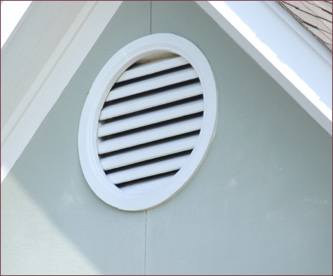
Silverfish
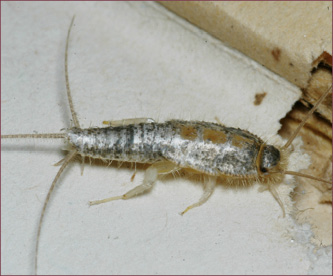
Silverfish are slender, somewhat carrot-shaped insects that do not have wings. Two long, filamentous antennae extend from the head end, and three long filaments extend from the end of the abdomen. Excluding these appendages, mature silverfish are about 1/2 inch long.
There are several species, with the common silverfish and the four-lined silverfish being the most common. Firebrats are similar in appearance and habits.
These insects have chewing mouthparts and feed on a variety of products, but they are especially fond of starches or flour products, so they are occasionally found in kitchen pantries and cabinets. They also feed on paper, especially paper that contains starch or other organic material, chewing irregular holes. This is the damage that is most commonly associated with silverfish, and it usually occurs on books or papers that are being stored for long periods. Silverfish often cause heavy damage to the bindings of older books. In older homes, they also may damage wallpaper.
These insects are attracted to moisture and often occur in bathroom areas, under kitchen sinks, and in other moist locations. Occasionally, they will feed on articles of clothing or other fabrics made of cotton or silk. Fabrics that are heavily starched or contain other organic material are especially susceptible. They do not feed on wool. Heavy infestations sometimes occur in attics, basements, or other storage areas, especially if cardboard boxes, books, or other paper products are being stored.
Silverfish Control
You can control limited infestations with residual sprays of appropriately labeled ready-to-use or aerosol household insect sprays that contain active ingredients such as bifenthrin, cyfluthrin, deltamethrin, lambda-cyhalothrin, permethrin, or tralomethrin. Remove items from the infested area and then apply the insecticide according to label directions, taking special care to treat cracks, crevices, and voids. Dusts containing 0.05 percent deltamethrin or diatomaceous earth/silica gel can be used to treat inaccessible voids or deep cracks and crevices.
For heavy, large-scale infestations, like those that sometimes occur in attics or basements, granular baits containing boric acid can be useful. Be sure to use baits with small granules that specifically list silverfish on the label, and apply according to label directions.
Table 9. Indoor treatments for control of silverfish.
|
Formulation |
Active Ingredient |
Brand Name (Examples) |
|
ready-to-use |
bifenthrin (0.05%) + zeta-cypermethrin (0.0125%) |
Ortho Home Defense Insect Killer |
|
cyfluthrin (0.05%) |
BioAdvanced Complete Insect Killer |
|
|
deltamethrin (0.02%) |
Bonide Household Insect Control |
|
|
gamma-cyhalothrin (0.025%) |
Spectracide Bug Stop Home Barrier |
|
|
permethrin (0.25%) |
Viper RTU |
|
|
dust |
deltamethrin (0.05%) |
Delta Dust |
|
deltamethrin (0.05%) |
Terro Ant Dust |
|
|
diatomaceous earth |
Perma Guard |
|
|
pyrethrins (1%) + pbo (10%) + silica dioxide (40%) |
Drione |
|
|
bait |
orthoboric acid (5%) |
Niban FG |
Springtails
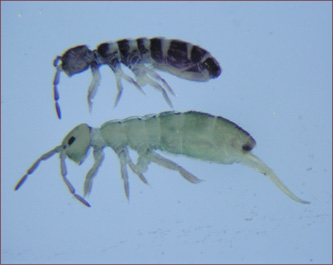
Springtails (order Collembola) are tiny arthropods that feed on fungi and decaying organic matter. There are many different species, but all have similar biology and habits. Some are active in the early spring in colder climates and are called “snow fleas.”
Springtails require high-moisture environments and usually live in woods duff, leaf litter, flowerbed mulch, potted plants, and similar locations. Some species occasionally occur inside homes, especially where there is some type of moisture problem or where large numbers of potted plants are kept. They are sometimes a persistent problem in wet, moldy basements or storerooms. Rooms with windows or doors that enter at, or below, ground level sometimes experience heavy invasions of springtails from outdoor breeding sites such as mulch or leaf litter.
Springtails do not bite and are essentially harmless, but they can be a nuisance when present in large numbers, which can happen in ideal conditions. Occasionally they migrate from nearby breeding sites in large enough numbers to clog filters of in-ground swimming pools. Springtails get their name from the spring-loaded structure on the underside of the abdomen, called the furcula. This structure allows them to leap mightily when disturbed. Springtails are often mistaken for fleas because of this jumping ability and their dark color.
Control of springtails should focus on correcting the moisture problem that is allowing them to thrive. Depending on the situation, this could entail repairing structural or plumbing leaks, moving indoor potted plants (or at least watering them less), raking mulch and leaves away from entrances to the house, moving outdoor sprinkler heads, changing watering schedules, and so on. Springtails are more abundant during or following rainy periods.
These tiny arthropods can be killed easily with many insecticides, but because moisture problems tend to degrade insecticide activity, insecticides will not provide permanent relief.
House Flies and Other Large Flies
The problem of having flies in the house is not nearly so common today as it was before window screening, air conditioning, and automobiles. Flies can still be a problem, but not on the same scale or frequency as they were when most homeowners stabled or grew some type of livestock in their backyards. Homes located near large-scale animal production facilities or homes with large pet kennels or horse stables can still experience heavy, persistent fly infestations, and a few flies still get into most homes occasionally. Some of the most common home-invading flies are briefly discussed below. These flies are often collectively referred to as “filth flies” because of where they breed.
House Fly

House flies, Musca domestica, are our most common home-invading flies. The house fly is gray with four dark stripes down the middle portion of the back. It is approximately 1/5 inch long. House flies occur worldwide, always living in close association with humans. The larvae are legless, white maggots that breed in our garbage, in human waste, and in the waste of the animals we grow. Under warm conditions, house flies complete a generation in about 2 weeks, hatching from eggs into maggots, which feed for several days and then pupate and emerge as adult flies.
Stable Fly
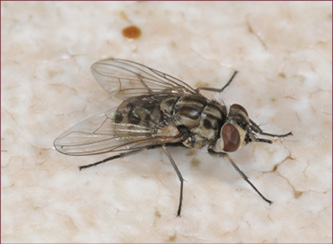
Stable flies, Stomoxys calcitrans, are rarely seen indoors, but they often congregate around the outside of buildings located near suitable breeding sites. These flies breed in decaying plant material, especially if it contains animal urine or feces, and are especially common around barns and stables where hay is fed. Stable flies look a lot like house flies, but the females feed on blood and occasionally bite people and pets. Dogs are often bitten on the ears and other areas where hair is thin or short. You can easily distinguish these two flies by viewing a resting fly from the side and observing its mouthparts. House flies hold their bulb-shaped proboscis pointed down, but stable flies rest with their sharp proboscis pointed forward, in a bayonet-like position.
Blow Fly or Bottle Fly
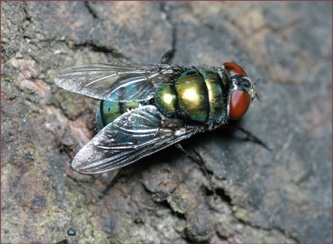
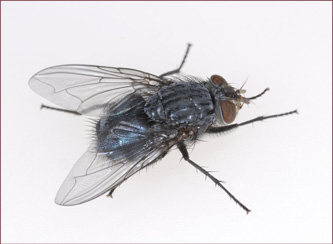
Blow flies or bottle flies (family Calliphoridae) are metallic green or blue flies that usually buzz about annoyingly when they get inside. There are many species. Their maggots develop in the bodies of dead animals, feces, or garbage. The appearance of a significant number of blow flies in a home often indicates the presence of some type of small animal carcass, such as a dead rat in a wall void, a bird that became trapped in the chimney, or the body of some small animal that was brought inside by the family cat, or pet feces.
Flesh Fly

Flesh flies (family Sarcophagidae) are gray flies often with darker stripes along their backs. They range from the size of a house fly to two to three times larger, depending on the species. As their name suggests, the maggots of many species of flesh flies develop in decaying animal carcasses, but many species are parasites of other insects. As with blow flies, flesh flies in the home may indicate the presence of some type of small animal carcass.
Tachinid Fly
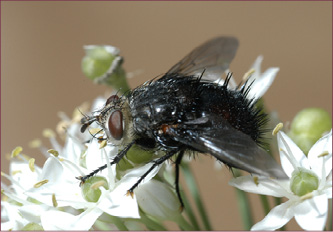
Tachinid flies (family Tachinidae) are large, dark, hairy flies. There are hundreds of species, most of which are insect parasites. The adults lay their eggs on a caterpillar or some other insect host, and the resulting maggots bore into the insect and consume it. Because they are not filth-breeders, they are rarely numerous indoors, but they buzz about annoyingly when they do get inside.
Black Soldier Fly
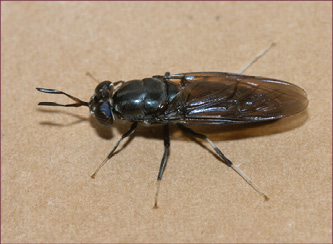
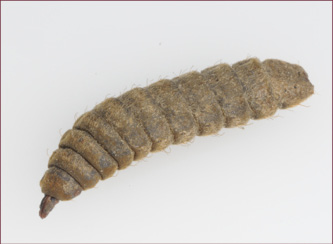
Black soldier flies, Hermetia illucens, are large, black flies that are often mistaken for wasps. They are approximately 5/8 inch long with black, wasp-shaped bodies and smoke-colored wings. Like all flies, they have only one pair of wings rather than the two pairs wasps and other flying insects have. The rear legs are black with wide, white bands.
Because the maggots breed in animal manure, they are more commonly seen in homes near animal-rearing facilities. Soldier flies also breed in sewage, and the mature larvae occasionally invade homes by crawling up sewer lines in search of a place to pupate. When this occurs, there is often some nearby break in the sewer line outside the house that lets adult soldier flies enter and lay eggs. The larvae are dark-colored, about 3/4 inch long, elliptical-shaped, and somewhat flattened. They have a tough, leathery, deeply segmented skin.
Fly Control
Fly control can be as simple as using a fly swatter or as complex as trying to manage flies in and around a large, caged poultry farm. Although this publication focuses on controlling flies inside the home, keep in mind that most home-invading flies originate from some nearby outside source. This outside source could be a farm or large animal-production facility, but it is more likely something closer to home, like household garbage, pet feces in the backyard, or some other decaying organic matter.
Sanitation
Sanitation is the most important component of fly control. If flies don't have access to suitable breeding sites nearby, they won't be a problem. Detailed discussion of fly management on farms and animal-production facilities is beyond the scope of this publication, but homeowners need to be aware that large numbers of flies can also breed in pet feces. Most eggs are laid within 24 hours after the feces is deposited, and it can take less than 1 week for the larvae to develop and crawl away from the feces to pupate. Break the fly production cycle by “scooping the poop” and properly discarding it or taking other steps to limit fly access to pet feces. Design backyard kennels so you can clean them easily and frequently, directing the waste into the sewer system or some other sewage-management device.
Surprisingly large numbers of flies can also breed in garbage and garbage cans, whether they are indoors or outdoors, and in dumpsters. Prevent flies from having access to garbage by placing the garbage in sealed plastic bags and disposing regularly. Use garbage cans with tight-fitting lids, and clean them regularly. Flies readily breed in spilled food and other organic matter that accumulates on the bottoms or sides of cans. You can use fly strips containing dichlorvos (Vapona) to help control flies in outdoor dumpsters and other large garbage-holding containers, but these are no substitute for keeping containers clean and emptying them frequently.
Exclusion
Exclusion is second only to sanitation in its importance in fly control. Keeping doors and windows properly screened or closed is just as important today as it was in past generations. Near-universal adoption of air conditioning makes this much easier to accomplish today. Still, there are situations where flies frequently enter homes as people come and go. Usually, these are in rural settings where homes are located near a stable, dog kennel, or some other animal-production facility.
Air Curtains
Flies actively try to enter homes when doors are opened because they can smell cooking odors and other odors associated with human habitation that are attractive to them. Air curtains are exclusion devices that are normally used to minimize the number of flies and other insects that enter through frequently used doors of commercial buildings. Some fit over standard-sized doorways, and these can be useful in homes persistently plagued by flies. Air curtains work by directing a strong flow of air across a doorway when the door is opened. When properly installed and adjusted, they can prevent most flying insects from entering. Air curtains also help conserve energy by keeping cool air in and hot air out. You have to be pretty desperate to resort to using air curtains in a home, but if you have severe fly populations originating from a breeding source beyond your control, air curtains can provide much-needed relief. You won't find air curtains at the local hardware store, but you can order them from many different sources.
Light Traps
ULV light traps are another method of fly management frequently and successfully used in large commercial facilities. They are available in many sizes, including sizes for use inside the home. Some are decorative. Light traps attract flies to an ultraviolet light, where they become trapped in a glue board behind the light. Models that electrocute flies and other insects are not recommended for indoor use because they can produce air borne insect particles that can potentially cause problems with allergies and contaminate foods.
Light traps are simple and effective, but they require maintenance. You must change the glue boards regularly because they lose their stickiness or become coated with flies. Light bulbs should be replaced yearly, even if they are still glowing, because they gradually lose their ability to produce the wavelengths of light that are most attractive to flies. Light traps work best when installed waist- to shoulder-high in dark areas where there is no other competing light source. Depending on the situation, you may need to use several light traps placed at different locations in the home.
Insecticides
For flies that manage to get inside and evade the light traps, a fly swatter is usually a better last-resort treatment than insecticides. Insecticides are best reserved for fly control in outside situations and around animal production facilities. Even in these situations, insecticides are less important than good sanitation practices.
Indoor space sprays: Occasionally, there is a need to control large numbers of flies that get indoors or congregate on porches or patios. Many commercially available aerosol sprays give immediate, though short-term, control of flies. Most contain active ingredients such as permethrin, tetramethrin, sumithrin, pyrethrins, allethrin, phenothrin, or some combination of these insecticides. Apply space sprays by directing the aerosol spray upward into the room for the specified amount of time, and then vacate and close the room for the required amount of time. Not all aerosol insecticides are labeled for use as space sprays, so be sure to read all label directions carefully before applying any aerosol spray as a space spray, and apply according to label directions. Some total-release aerosol foggers are also labeled for fly control.
Outdoor fly control: In some situations, usually homes in rural areas near barns, stables, or other large animal-production facilities, large numbers of house flies and other flies congregate around the outside of homes, resting on walls and other surfaces. These flies are a nuisance to people using porches, patios, and other outside areas, and many make their way inside the home. Fly bait strips may be useful in these situations when house flies are the primary pest. Because these strips attract house flies, don't place them near entrances. Bait strips give off a strong odor and should be used outdoors only. Spray-on fly baits that can be applied to strategic locations on and around building exteriors and garbage receptacles can also be useful.
Table 10. Treatments for control of flies indoors.
|
Formulation |
Active Ingredient |
Brand Name (Example) |
|
aerosol space spray |
permethrin (0.15%) + allethrin (0.25%) |
Hot Shot Flying Insect Killer |
|
tetramethrin (0.2%) + sumithrin (0.2%) |
Enforcer Flying Insect Killer |
|
|
tetramethrin (0.2%) + phenothrin (0.2%) |
Ortho Flying Insect Killer |
|
|
stick-on bait stickers |
acetamiprid 4.4% |
Ortho Fly Bait Decal |
|
acetamiprid 4.4% |
End Zone Insecticide Sticker |
Table 11. Treatments for control of house flies around the outside of homes.
|
Formulation |
Active Ingredient |
Brand Name (Example) |
|
spray-on bait, ready-to-use |
dinotefuran (1%) |
Alpine Pressurized Fly Bait |
|
spray-on bait, concentrate1 |
imidacloprid (10%) |
Maxforce Fly Spot Bait |
|
fly bait strip2 |
nithiazine |
QuickStrike Fly Abatement Strip |
|
insecticide pest strip3 (for use in dumpsters and similar enclosed situations; not for exposed outdoor use) |
dichlorvos 18.6% |
Prozap Insect Guard |
|
Hot Shot No-Pest Strip |
1Concentrates must be diluted with water and applied with an appropriate sprayer.
2Bait strips are attractive to flies. They feed on the strip and consume the insecticide. Bait strips should be used outdoors only.
3Insecticide pest strips do not attract flies. They release a volatile insecticide into the surrounding air. Use insecticide pest strips in dumpsters or other large outdoor garbage containers to prevent flies from breeding. These strips do not work in exposed outdoor situations.
Fruit Flies, Drain Flies, and Other Small Flies
Several species of small, gnat-sized flies occur in homes. Although these flies are so small that they often go unnoticed, they can be real nuisances when they become numerous. The key to controlling these pests is to identify their breeding source and either remove it or make it unattractive to the flies. Some of the small flies that most often occur in homes are briefly discussed below. Note that none of these are biting flies. Biting or blood-sucking flies such as mosquitoes or biting midges rarely breed indoors.
Fruit Fly
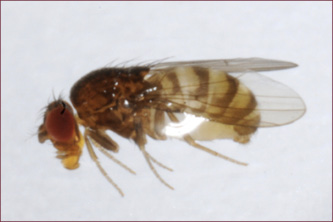
Fruit flies, Drosophila spp., are less than 1/8 inch long and brown to gray. They have red eyes. They are also known as vinegar flies, and as their common names suggest, these flies often breed in decaying fruit or vegetables, as well as in other types of decaying organic matter. They are often seen flying about overripe bananas, tomatoes, empty juice or wine bottles, or similar items. These small flies can reproduce quite successfully in the few drops of liquid in the bottom of empty drink cans or juice bottles.
Phorid Fly
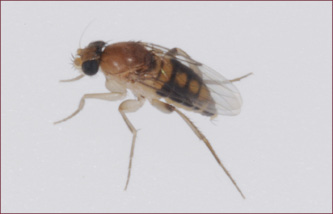
Phorid flies (family Phoridae) are 1/8 inch or less, depending on species, and gray to dark gray. They have a distinctly hump-backed appearance when viewed from the side. The eyes are dark-colored, rather than red as in fruit flies. These small flies breed in a wide range of decaying organic matter, including decaying vegetable matter or meat, animal feces, and many other sources. They are sometimes referred to as drain flies because the larvae of some species feed on the organic scum that accumulates inside drainpipes and garbage disposals. Phorids can also breed in the residue inside garbage cans that are not cleaned frequently and in moist food residues that accumulate under and around stoves and other appliances.
Moth Fly
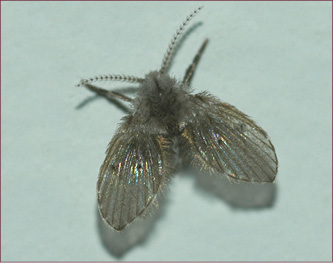
Moth flies (family Psychodidae) are small and have dark, moth-like wings. They are also called drain flies or sewage gnats. They are only about 1/8 inch long and may be seen resting on bathroom or kitchen walls, near the drain from which they probably emerged. The larvae breed in sewage and other organic accumulations in drainpipes, and the adults then fly up the pipes and into the kitchen or bathroom.
Fungus Gnat
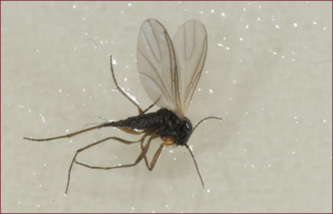
Fungus gnats (family Sciaridae or Mycetophilidae) are tiny, dark-colored, clear-winged, mosquito-shaped flies that occur indoors where houseplants are kept. The larvae breed in the potting media, feeding on fungi growing on the roots of the plants and in the potting media, as well as on the roots themselves. These small flies do not bite, but when numerous, they can become a nuisance by hovering around the TV, computer monitor, or other light sources in darkened rooms.
Small Fly Control
Routine sanitation and maintenance practices help prevent gnat infestations. Line garbage cans with plastic bags, and take out garbage regularly. Promptly clean up any spilled food or garbage, being especially aware of accumulations under or behind appliances. Store fruits and vegetables in designated areas, and regularly check and dispose of any that are overripe or rotten. Repair plumbing and/or structural leaks. Regularly inspect, empty, and clean drain pans under refrigerators, air conditioners, or other appliances. Use properly labeled algicides to prevent accumulations of algae in air conditioner drain pans. Avoid overwatering houseplants, and empty and clean drain saucers regularly. Be sure indoor pets are housebroken, and empty litter boxes regularly. Clean drains regularly with an appropriately labeled microbial drain cleaner.
When infestations of small flies occur, the best way to control them is to find and eliminate their breeding source. It may take a bit of detective work to accomplish this, and it helps to be able to identify the kind of flies involved. Examples of some of the most common breeding sites for these small flies are listed below, but keep in mind these flies can breed in any type of moist organic matter.
Common Sources of “Gnat” Infestations
- a tomato or such that has rolled behind the refrigerator (fruit flies or phorid flies)
- a partially eaten banana a toddler “lost” under a piece of furniture (fruit flies)
- a bag of potatoes or fruit that was inadvertently set in some nonroutine spot and forgotten (phorid flies or fruit flies)
- empty soda cans, beer cans, wine bottles, or fruit juice bottles being saved for recycling (fruit flies)
- garbage disposals (phorid flies)
- drains in the kitchen, bathroom, or laundry (moth flies or phorid flies)
- wet areas under washing machines or dishwashers (phorid flies or moth flies)
- wet areas from plumbing or structural leaks (phorid flies)
- drain pans for refrigerators, air conditioners, or other appliances (phorid flies or fungus gnats)
- dirty, unlined garbage cans (phorid flies or fruit flies)
- garbage cans that are not emptied frequently (phorid flies or fruit flies)
- accumulations of food matter under or behind appliances (phorid flies)
- houseplants (fungus gnats)
- vases of cut flowers that have stood too long (phorid flies)
- wet organic matter in drain saucers used for house plants (fungus gnats or phorid flies)
- leaks in plumbing lines or shower drains under the slab (phorid flies or moth flies)
- pet feces (phorid flies)
“Drain Fly” Control
Moth flies and some species of phorid flies breed in the organic scum that accumulates on the insides of drainpipes. The larvae live in this organic scum, but the adult flies exit the drain and fly about the room.
You can check to see if drain flies are coming from a particular drain by getting a commercially available sticky trap, folding and taping it into a tube or triangle, sticky side in, and placing it over the drain opening. Leave the top open for air movement. Leave this trap in place while you're not using the drain, and check for flies. Alternatively, you can invert a clear plastic or glass jar over the drain opening. This restricts airflow, but if the drain is heavily infested, you will probably still catch some flies.
The key to controlling drain flies is to eliminate the organic scum that coats the insides of the pipes where the small fly larvae live. Inorganic drain cleaners don't work as well for this as you might think, but several microbial drain cleaners do an excellent job when used regularly according to the label. Microbial drain cleaners may be hard to find locally, but you can buy them from mail-order suppliers. When cleaning drains that have been neglected for some time, you may need to use an appropriately designed brush to physically clean the interior of the pipes and/or to apply several consecutive treatments of microbial drain cleaner. Never use insecticides in drains.
Drain flies, as well as other flies, occasionally become abundant in guest bedrooms or other areas of the home with bathrooms or other drains that are used infrequently. Many times, the problem is simply that the water has evaporated out of the J-trap in the toilet or drain, allowing adult flies that developed farther down the sewer system to fly directly up the pipes. This can also allow sewage gases to infiltrate the room, resulting in an unpleasant odor, which may also attract flies into the room from other sources. In this situation, simply flushing the toilet or running water into the sink or tub to refill the J-trap may be all that is necessary to solve the problem.
Brand name examples of microbial drain cleaners used for drain fly control include Drain Gel, InVade Bio Drain, DF 5000 Drain Cleaner, and Vector Bio-5.
Fungus Gnat Control
Indoor infestations of fungus gnats are almost always associated with houseplants, especially overwatered ones. Proper watering and regularly emptying and cleaning drain saucers greatly reduce the potential for fungus gnat problems. Still, some fungus gnats are likely to occur anywhere large numbers of houseplants are kept.
Yellow sticky traps are readily available from garden supply sources. These are more useful as survey tools than for control, but they do catch some gnats. Glue board-style ULV light traps are a more effective means of attracting and trapping these small flies, and placing one or more small light traps in the area where houseplants are kept will help control these pests.
You can control fungus gnat larvae in pots by drenching with insecticides containing Bacillus thuringiensis var. israelensis. Knock-Out Gnats is one example of a B.t. israelensis product that is sold commercially for use by homeowners. Gnatrol is a similar product that is more commonly used in commercial nurseries and greenhouses and by serious hobbyists.
Note that there are different types of B.t. insecticides. Those used to control caterpillar pests on garden vegetables or ornamental plants (usually B.t. var. kurstaki or aizawai) do not control fly larvae.
The botanical insecticide azadirachtin (Azatrol is one example) can also be used as a potting medium drench to control fungus fly larvae, but it is slower acting than the B.t. products and is best used preventively.
If you have a lot of houseplants, you may want to investigate biological control products such as nematodes or mites, especially Hypoaspis mites. You can get these from suppliers that rear biocontrol organisms for commercial nurseries and greenhouses. But this type of biological control is best for large commercial operations and serious hobbyists with large greenhouses or atriums.
This work is partially supported by Crop Protection and Pest Management, Extension Implementation Program, award no. 2021-70006-35580 from the USDA National Institute of Food and Agriculture. Any opinions, findings, conclusions, or recommendations expressed in this publication are those of the author(s) and do not necessarily reflect the view of the U.S. Department of Agriculture.
The information given here is for educational purposes only. References to commercial products or trade names are made with the understanding that no discrimination is intended against other products that may also be suitable. Always read and follow the current label directions of any insecticide you choose to use.
Publication 2443 (POD-05-22)
By Blake Layton, PhD, Extension Professor, Entomology.
Copyright 2022 by Mississippi State University. All rights reserved. This publication may be copied and distributed without alteration for nonprofit educational purposes provided that credit is given to the Mississippi State University Extension Service.
The Mississippi State University Extension Service is working to ensure all web content is accessible to all users. If you need assistance accessing any of our content, please email the webteam or call 662-325-2262.

